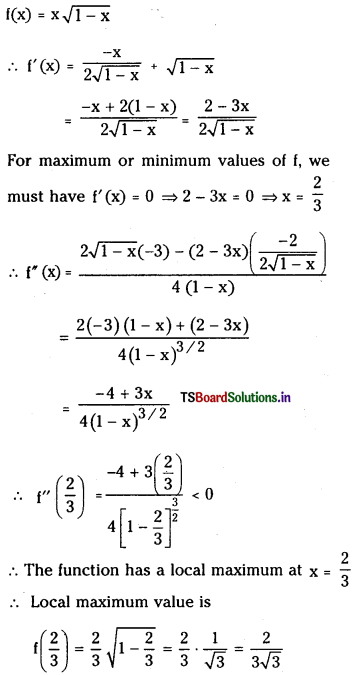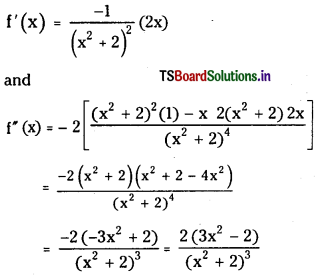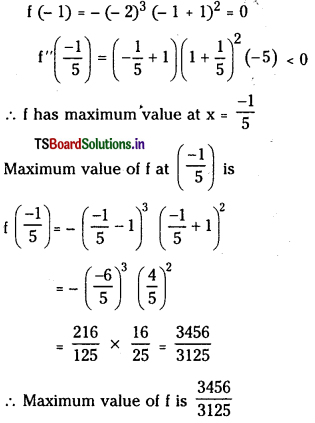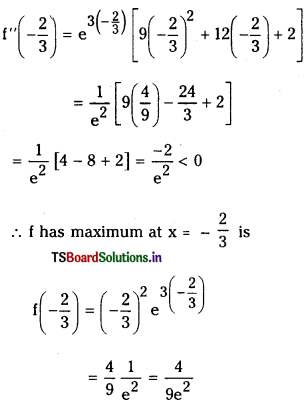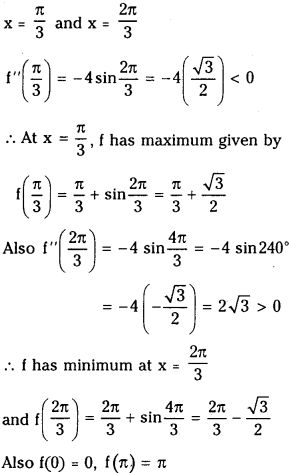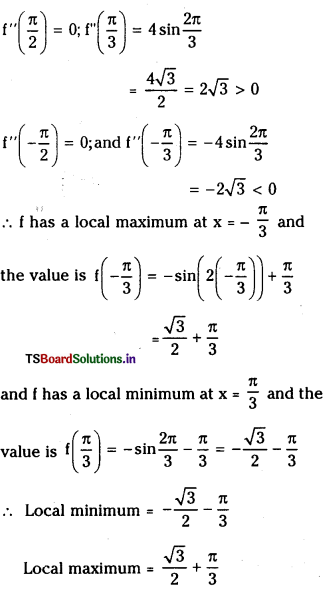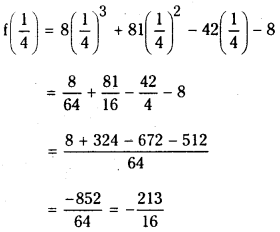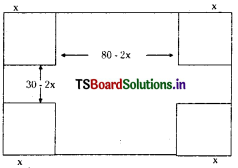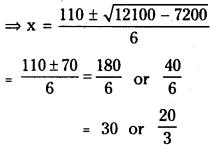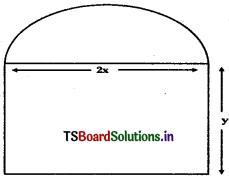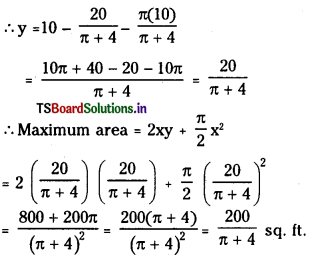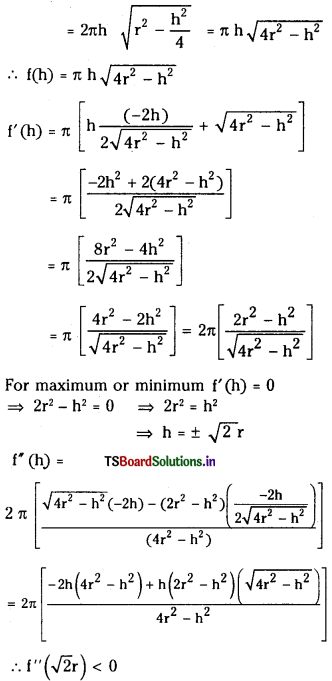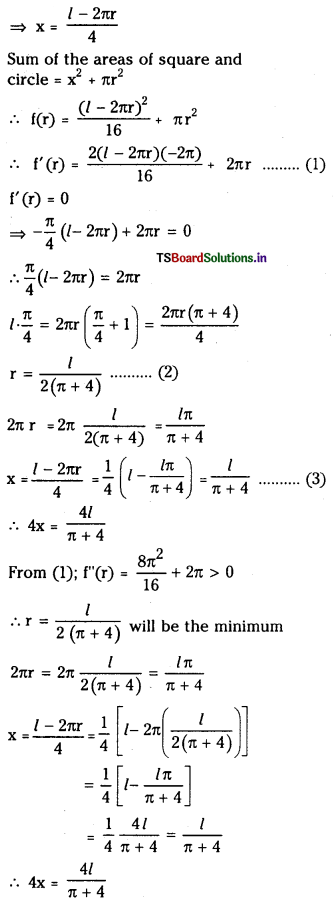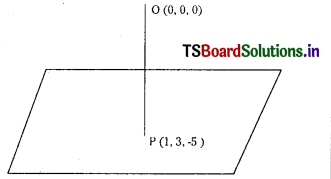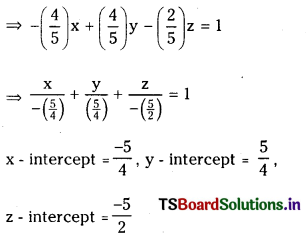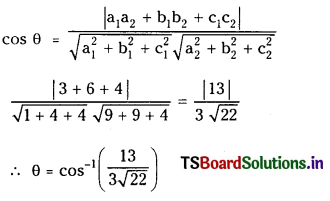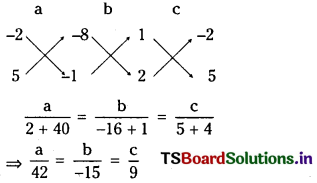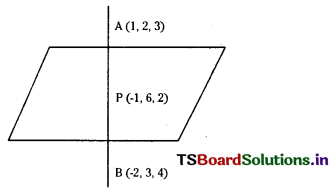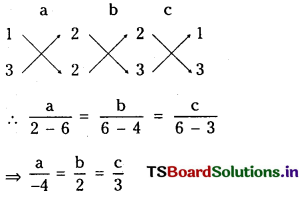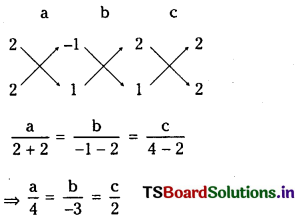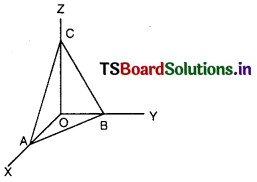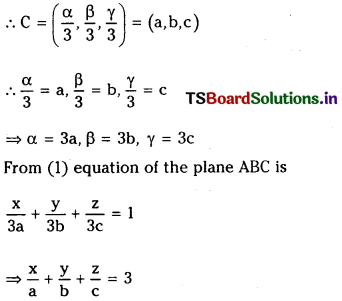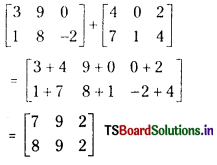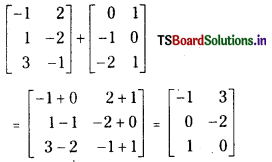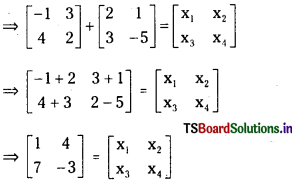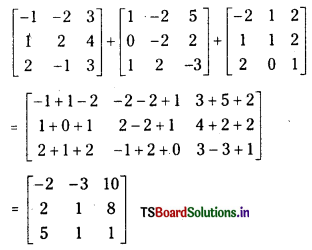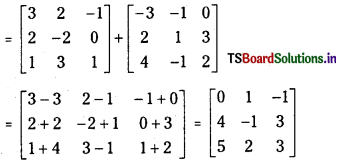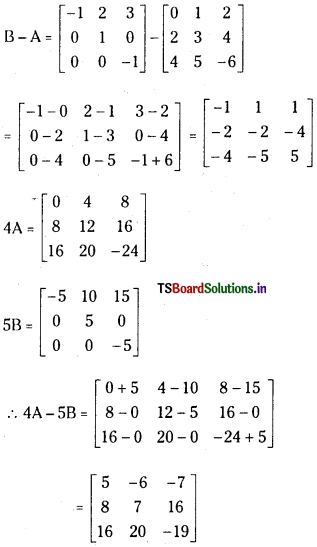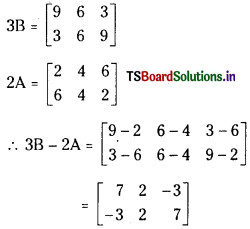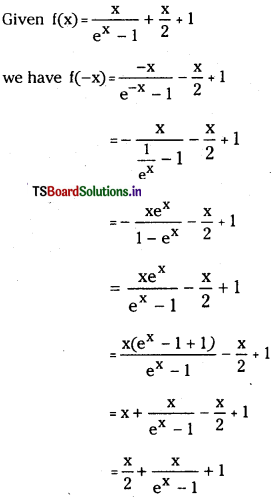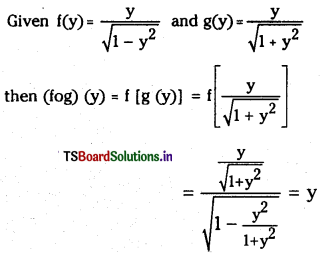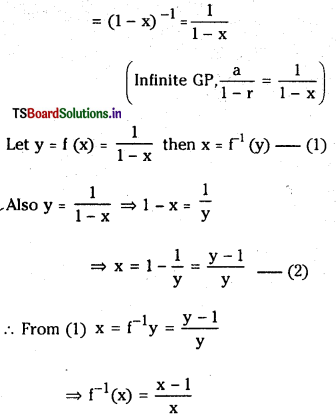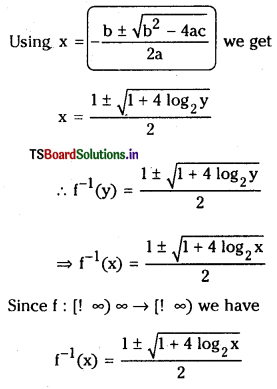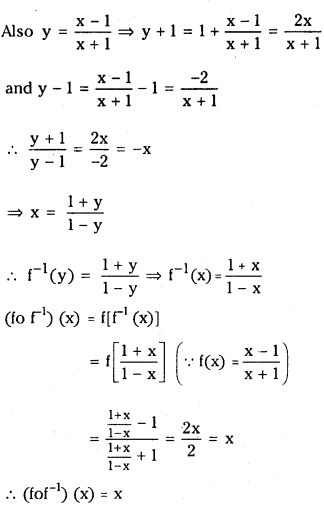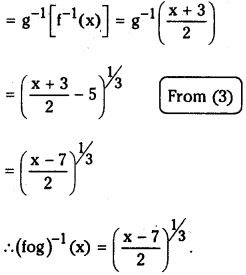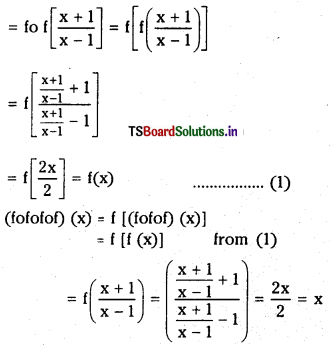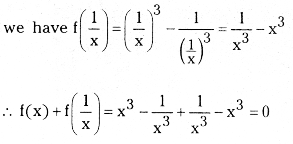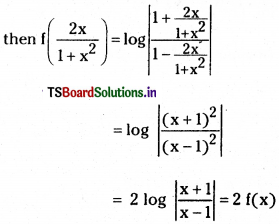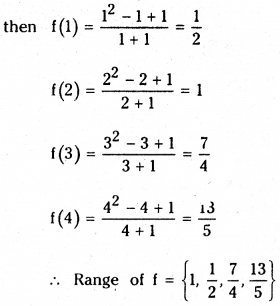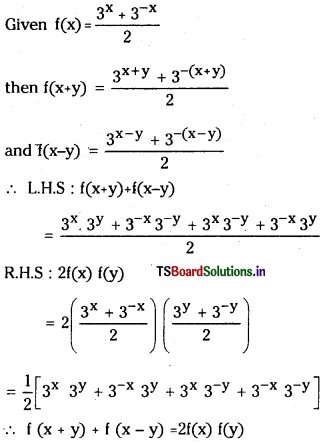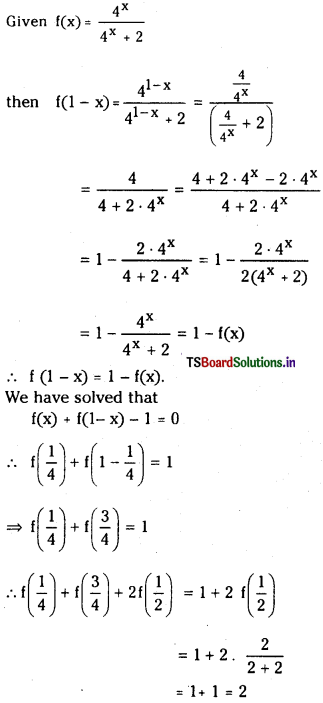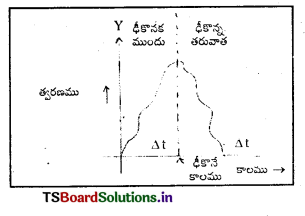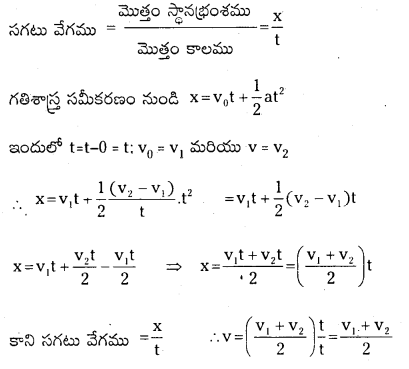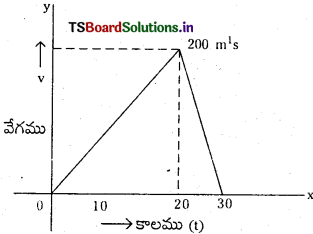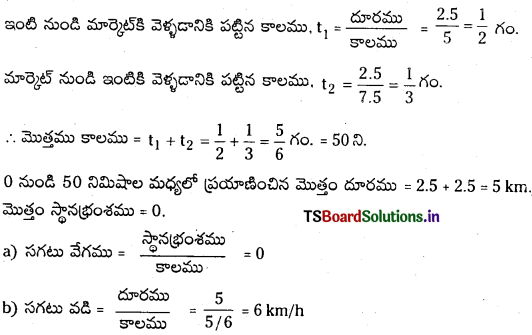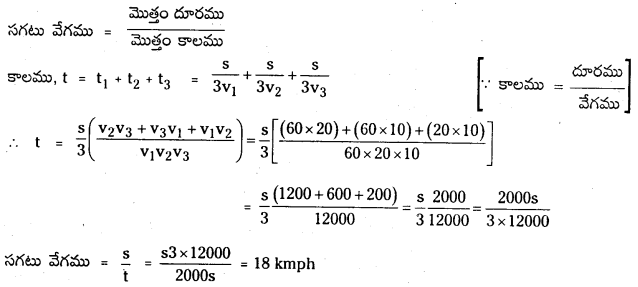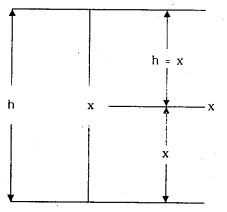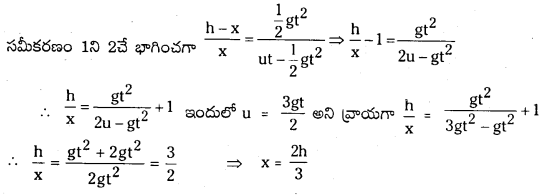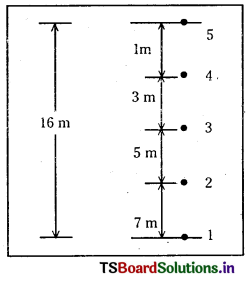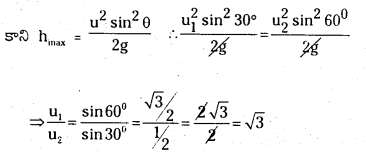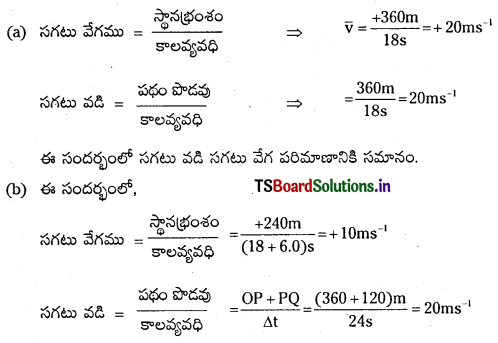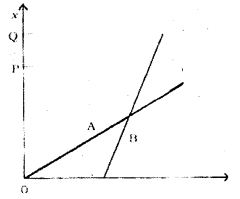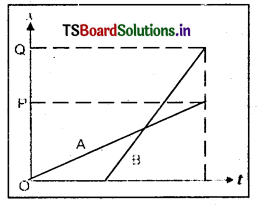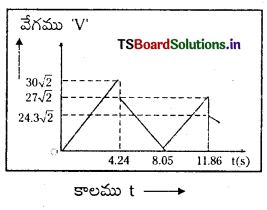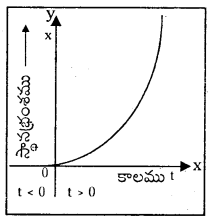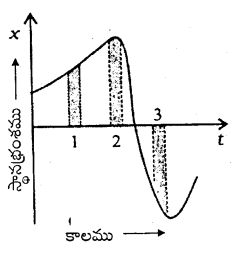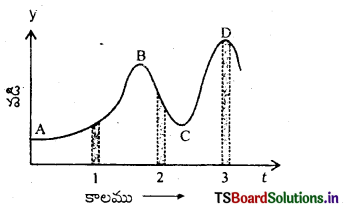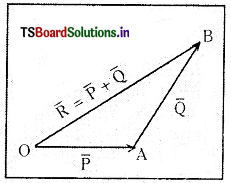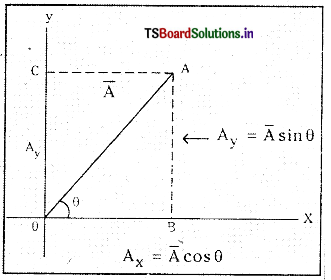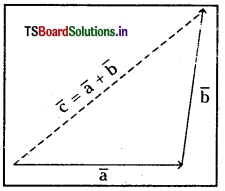Telangana TSBIE TS Inter 1st Year Physics Study Material 4th Lesson సమతలంలో చలనం Textbook Questions and Answers.
TS Inter 1st Year Physics Study Material 4th Lesson సమతలంలో చలనం
అతిస్వల్ప సమాధాన ప్రశ్నలు
ప్రశ్న 1.
ఒక సదిశ నిలువు అంశం దాని క్షితిజ సమాంతర అంశానికి సమానం. ఆ సదిశ x-అక్షంతో చేసే కోణం ఎంత ?
జవాబు:
ఒక సదిశ Ā నిలువు అంశం Ā⊥ = Ā sin θ.
క్షితిజ సమాంతర అంశం A|| = Ā cos θ
A⊥ = A|| అయితే వాటి మధ్య కోణము tan θ = \(\frac{\mathrm{A}_{\perp}}{\mathrm{A}_{\|}}\) = 1
అనగా θ = 45°
ప్రశ్న 2.
ఒక సదిశ V క్షితిజ సమాంతరంతో రికోణం చేస్తుంది. ఆ సదిశను ఆ కోణం భ్రమణం చెందించడమైంది. ఈ భ్రమణం సదిశ V లో మార్పు తెస్తుందా ?
జవాబు:
నిర్దేశక అక్షాలను త్రిప్పినంత మాత్రాన సదిశ పరిమాణం మారదు. ఇచ్చిన సదిశ పరిమాణము = V
క్షితిజ సమాంతర అక్షంతో కోణము = θ (అనుకొనుము)
నిరూపకాక్షాలను త్రిప్పిన కోణము = e అయితే, క్షితిజ సమాంతరంతో కోణము θ + e అవుతుంది.
ఇప్పుడు క్షితిజ సమాంతరాంశం = Vx = V Cos (θ + e), క్షితిజ లంబ అంశం Vy = V sin (θ + e)
ఇచ్చిన సదిశ పరిమాణము V = \(\sqrt{v_x^2+v_y^2}\) = V \(\left(\sqrt{\cos ^2(e+\theta)+\sin ^2(e+\theta)}\right)=\) = V
కావున అక్షాన్ని భ్రమణం చెందించటం వల్ల సదిశ పరిమాణం మారదు.
ప్రశ్న 3.
3 ప్రమాణాలు, 5 ప్రమాణాల పరిమాణం ఉన్న రెండు బలాలు ఒకదానితో ఒకటి 60° కోణంలో పనిచేస్తున్నాయి. వాటి ఫలిత పరిమాణం ఎంత ?
జవాబు:
సదిశల పరిమాణాలు 3 యూనిట్లు, 5 యూనిట్లు. వాటి మధ్య కోణము = θ
∴ ఫలిత సదిశ R = \(\sqrt{3^2+5^2+2 \times 3 \times 5 \cos 60^{\circ}}=\sqrt{9+25+15}=\sqrt{49}\) = 7 యూనిట్లు.

ప్రశ్న 4.
\(\overrightarrow{\mathrm{A}}=\overrightarrow{\mathrm{i}}+\overrightarrow{\mathrm{j}}\) . ఈ సదిశ x-అక్షంతో చేసే కోణం ఎంత ?
జవాబు:
\(\overrightarrow{\mathrm{A}}=\overrightarrow{\mathrm{i}}+\overrightarrow{\mathrm{j}}\) స్థాన సదిశ పటంలో చూపినట్లు ఉంటుంది.
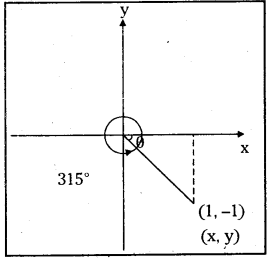
పటం నుండి tan θ = \(\frac{y}{x}\) = -1
∴ θ = 45° (సవ్యదిశలో అనగా 4వ పాదంలో ఉంటుంది.)
ప్రశ్న 5.
యూనిట్లు, 24 యూనిట్లు పరిమాణం ఉన్న రెండు లంబ సదిశలు సంయోగం చెందినట్లైతే ఫలిత సదిశ పరిమాణం ఎంత ?
జవాబు:
దత్తాంశం నుండి \(\overline{\mathrm{P}}\) = 7 యూనిట్లు; \(\overline{\mathrm{Q}}\) = 24 యూనిట్లు; వాటి మధ్య కోణము θ = 90°
∴ ఫలిత సదిశ \(\overline{\mathrm{R}}=\sqrt{\overline{\mathrm{P}}^2+\overline{\mathrm{Q}}^2+2 \mathrm{PQ} \cos \theta}=\sqrt{\overline{\mathrm{P}}^2+\overline{\mathrm{Q}}^2}\) (∵ cos 90° = 0)
∴ \(\overline{\mathrm{R}}=\sqrt{7^2+24^2}=\sqrt{49+576}=\sqrt{625}\) = 25 యూనిట్లు.
ప్రశ్న 6.
P = 2i + 4j + 14k, Q = 4i + 4j + 10k అయితే P + Q పరిమాణం కనుక్కోండి.
జవాబు:

ప్రశ్న 7.
శూన్య పరిమాణం కలిగిన సదిశకు శూన్యం కాని అంశాలు ఉంటాయా ?
జవాబు:
శూన్య సదిశ యొక్క అంశాలు శూన్యేతర పరిమాణమును కలిగి ఉండవు. ఎందుకనగా \(\overline{\mathrm{V}}=\sqrt{\mathrm{V}_{\mathrm{x}}^2+\mathrm{V}_{\mathrm{y}}^2}\) కావున \(\overline{\mathrm{V}}\) = (0) కావాలంటే తప్పనిసరిగా Vx2 మరియు Vy2 సున్న కావలెను. అనగా Vx = Vy = 0 కావలెను.

ప్రశ్న 8.
ప్రక్షేపకం యొక్క ప్రక్షేప పథం అగ్రభాగంలో దాని త్వరణం ఎంత ?
జవాబు:
ప్రక్షేపకం అగ్రభాగంలో త్వరణము గురుత్వత్వరణము g = 9.8 మీ/సె2. ఇది భూమి కేంద్రంవైపు పనిచేస్తుంది.
ప్రశ్న 9.
రెండు అసమ పరిమాణం వున్న సదిశల సంకలన మొత్తం శూన్య సదిశను ఇవ్వగలదా ? మూడు అసమాన సదిశలు కలిసి శూన్య సదిశను ఇవ్వగలవా ?
జవాబు:
శూన్యం కాదు. రెండు అసమాన సదిశల ఫలిత సదిశ శూన్యం కాదు. కాని ఒకే సమతలంలో గల మూడు అసమాన సదిశల ఫలిత సదిశ శూన్యం కావచ్చును.
స్వల్ప సమాధాన ప్రశ్నలు
ప్రశ్న 1.
సదిశల సమాంతర చతుర్భుజ నియమాన్ని పేర్కొనండి. ఫలిత సదిశ పరిమాణం, దిశలకు సమీకరణం రాబట్టండి.
జవాబు:
సమాంతర చతుర్భుజ నియమం : “ఒక బిందువు వద్ద, ఏక కాలంలో పనిచేసే రెండు సదిశలను పరిమాణంలోను, దిశలోను సమాంతర చతుర్భుజం యొక్క రెండు ఆసన్న భుజాలతో సూచిస్తే అదే బిందువు గుండా పోయే కర్ణం రెండు సదిశల ఫలిత సదిశను పరిమాణం మరియు దిశలోను సూచిస్తుంది.”
P, Q అను రెండు అనుషక్త సదిశలు ‘O’ వద్ద పనిచేయుచున్నవి. OA, OB భుజాలు ఆ రెండు సదిశల పరిమాణం మరియు దిశను సూచిస్తాయి. OA, OB ల మధ్యకోణం ‘θ’ అనుకొనుము. OA, OB లను ఆసన్న భుజాలుగా తీసుకొని సమాంతర చతుర్భుజం OACB ని నిర్మించండి.
OA ని పొడిగించి, దానిపై C నుండి లంబం గీస్తే ఆ లంబం OAని D వద్ద కలుస్తుంది. ODC లంబ కోణ త్రిభుజం కనుక, OC2 = OD2 + DC2
కాని OD = OA + AD, ∴ OC2 = (OA + AD)2 + DC2 = OA2 + 2 (OA) (AD) + AD2 + DC2
కాని AD2 + DC2 = AC2 = OB2 (ADC లంబకోణ త్రిభుజం కనుక)
∴ OC2 = OA2 + 2 (OA) (AD) + OB2
\(\frac{\mathrm{AD}}{\mathrm{AC}}\) = cos θ కనుక
OC2 = OA2 + 2(OA) (AC) cos θ + OB2
∴ \(\overline{\mathrm{R}}^2\) = OC2 = OA2 + 2 (OA)(OB)cosθ + OB2
= P2 + 2PQ cos θ + Q2
∴ R = \(\sqrt{\mathrm{P}^2+\mathrm{Q}^2+2 \mathrm{PQ} \cos \theta}\) ఇది రెండు సదిశల ఫలిత విలువ Rని తెలియచేస్తుంది.
R ఫలిత సదిశ OA తో α కోణం చేస్తుంది అనుకుంటే,

ఇక్కడ α ఫలిత సదిశ ఆసన్న భుజంతో చేయు కోణమును తెలియజేస్తుంది.

ప్రశ్న 2.
సాపేక్ష చలనం అంటే ఏమిటి ? వివరించండి.
జవాబు:
సాపేక్ష వేగము : గమనం ఉన్న రెండు వస్తువులు A, B ల వేగాలను ఒకదానితో పోల్చి వేరొకదాని వేగాన్ని వివరించడాన్ని సాపేక్ష వేగము అంటారు. అనగా ఇటువంటి చలనంలో A పరంగా B వేగాన్ని (VBA) లేదా B పరంగా A వేగాన్ని (VAB) వివరించడాన్ని సాపేక్ష వేగం అంటారు.
వివరణ : రెండు వస్తువులు A, B లు ఒకే అక్షం వెంబడి VA మరియు VB అను సగటు వేగంతో చలిస్తున్నాయనుకోండి. కాలము t = 0 వద్ద వాటి స్థానాలు XA = XB = 0 అనుకుందాం. t కాలం తరువాత వాటి స్థానాలు వరుసగా XA (t) మరియు XB (t) అనుకుంటే
XA (t) = XA (0) + VAt
XB (t) = XB (0) + VBt అవుతాయి..
ఇప్పుడు A నుంచి B స్థానభ్రంశం XBA (t) = XB (t) – XA (t)
లేదా XBA (t) = XB (0) + VB t – XA (0) – VAt
XBA (t) = XB (0) – XA (0) + (VB – VA) t
XA, XB ల తొలిస్థానాలు సున్న అని భావిస్తే XBA (t) = (VB – VA) t
A పరంగా B సాపేక్ష వేగము = \(\frac{X_{B A}(t)}{t}\) VB – VA = VBA
అనగా రెండు వస్తువులు ఒకే దిశలో చలిస్తే వాటి సాపేక్ష వేగము ఆ వస్తువుల విడివిడి వేగాల బేధానికి సమానము.
ఇదే విధంగా B పరంగా A వస్తువు సాపేక్ష వేగము VAB = VA + VB.
అనగా సాపేక్ష వేగాలలో VAB = -VBA
A, B లు వ్యతిరేక దిశలలో చలిస్తుంటే VAB = VA + VB.
అనగా వ్యతిరేక దిశలలో చలించే వస్తువుల సాపేక్ష వేగము వాటి విడివిడి వేగాల మొత్తమునకు సమానము.
ప్రశ్న 3.
కనిష్ఠ కాలంలో నదిని దాటడానికి నావ నది నీటితో కొంత కోణం చేస్తూ ప్రయాణం చేయాలని చూపండి.
జవాబు:
ఒక పడవ నిశ్చలమైన నీటిలో ఒడ్డు దృష్ట్యా VbE అను వేగంతో చలించగలదు అనుకొనుము. ఈ పడవను ఉపయోగించి ఒడ్డు దృష్ట్యా VwE వేగంతో చలిస్తున్న నదీ ప్రవాహాన్ని దాటవలెను. నది వెడల్పు W అనుకోండి.
నదిని అతి తక్కువ కాలంలో దాటడం :
నదిని అతి తక్కువ కాలంలో దాటడానికి పట్టిన కాలము
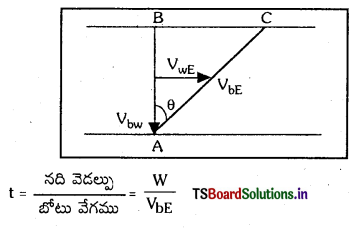
నదిని కనీసకాలంలో దాటాలంటే పడవ ఎల్లపుడు నది వెడల్పు దిశలోనే చలించాలి. అనగా పడవ ఒడ్డుకు లంబంగా (θ = 90°) చలించాలి. ఎందుకంటే మనం దాటడానికి కావలసిన అతి తక్కువ దూరం నది వెడల్పు W కావున.
ఈ సందర్భంలో పడవ వేగము VbE మరియు నది వేగము VwE లు పరస్పర లంబము కావున పడవ నది వెంబడి కొంతదూరము ప్రయాణిస్తుంది. పడవ ఫలిత ప్రయాణ మార్గం పటంలో చూపినట్లు AC దిశలో ఉంటుంది. కాని ఒడ్డుతో పోల్చితే పడవ ఎల్లపుడు లంబంగా (θ = 90°) చలించవలెను.

ప్రశ్న 4.
ప్రమాణ సదిశ, శూన్య సదిశ, స్థానాంతర సదిశలను నిర్వచించండి.
జవాబు:
ప్రమాణ సదిశ : ఏకాంక పరిమాణం గల సదిశను ఏకాంక సదిశ లేక ప్రమాణ సదిశ అంటారు.
ఇచ్చిన సదిశను \(\overline{\mathrm{a}}\) అనుకొన్నపుడు \(\overline{\mathrm{a}}\) యొక్క ప్రమాణ సదిశ \(\hat{a}=\frac{\bar{a}}{|\bar{a}|}\) గా నిర్వచించినారు.
శూన్య సదిశ : ఏదైనా సదిశ పరిమాణం శూన్యమైతే దానిని శూన్య సదిశ అంటారు. శూన్య సదిశకు ఆరంభ బిందువు అంత్య బిందువులు ఒకదానితో ఒకటి ఏకీభవిస్తాయి. అటువంటి సదిశ దిశను నిర్ణయించలేము.
ఉదా : \(\overline{\mathrm{A}} \times \overline{\mathrm{B}}\) = 0 అయితే దానిని \(\overrightarrow{\mathrm{O}}\) శూన్య సదిశగా వ్యవహరిస్తారు.
స్థాన సదిశ : అంతరాళంలో గల ఏదైనా బిందువును \(\overline{\mathrm{i}}, \overline{\mathrm{j}}\) మరియు \(\overline{\mathrm{k}}\) ప్రమాణ సదిశల రేఖీయ సంయోగంగా తెలుపవచ్చును. మూలబిందువు ‘0’ అయినపుడు P బిందువును \(\overrightarrow{\mathrm{OP}}\) తో సూచిస్తారు.
\(\overrightarrow{\mathrm{OP}}=x \bar{i}+y \bar{j}+z \bar{k}\) గా సూచిస్తారు. దీనిని P బిందువు స్థాన సదిశ అంటారు.
ఇందులో x, y మరియు 2 లు నిరూపకాక్షాలు \(\overline{\mathrm{i}}, \overline{\mathrm{j}}\) మరియు \(\overline{\mathrm{k}}\) ల వెంబడి గల పరిమాణాలను తెలుపుతాయి
\(\overrightarrow{\mathrm{OP}}\) పరిమాణాన్ని \(\overrightarrow{\mathrm{OP}}=\sqrt{\mathrm{x}^2+\mathrm{y}^2+\mathrm{z}^2}\) ద్వారా లెక్కగడతారు.
ప్రశ్న 5.
\(|\overrightarrow{\mathrm{a}}+\overrightarrow{\mathrm{b}}|=|\overrightarrow{\mathrm{a}}-\overrightarrow{\mathrm{b}}|\) అయితే, \(\overrightarrow{\mathrm{a}}, \overrightarrow{\mathrm{b}}\) ల మధ్య కోణం 90° అని చూపండి.
జవాబు:
|a|,|b| లు రెండు అనుషక్త సదిశలు అనుకోండి.
సదిశల మొత్తం పరిమాణము
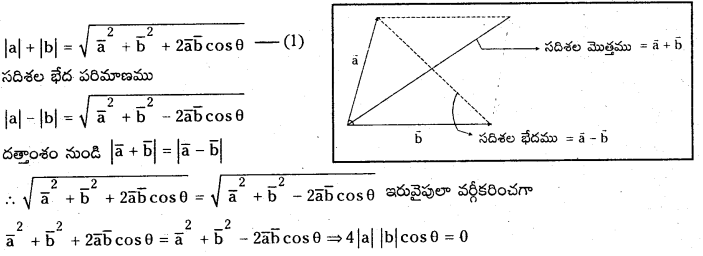
కాని |a|, |b| లు సున్న కావు కావున cos θ = 0 కావలెను. అనగా θ = 90° అనగా |a|, |b| ల మధ్య కోణము θ = 90°

ప్రశ్న 6.
క్షితిజ సమాంతర దిశకు కొంత కోణం చేస్తూ విసిరిన వస్తువు (ప్రక్షిప్త) పథం పరావలయం అని చూపండి. (మే 2014)
జవాబు:
క్షితిజ సమాంతర తలంలో θ కోణం చేయునట్లు u వేగంతో ఒక వస్తువుని పైకి విసిరామనుకుందాము. ప్రక్షేపకము ప్రయాణించిన మార్గాన్ని ప్రక్షేపకపు గమన పథము అంటారు. ప్రక్షేపకాలలో వస్తువుపై గురుత్వ త్వరణం g మాత్రమే పనిచేస్తుంది. ఇది ఎల్లప్పుడూ నిలువుగా క్రిందికి ఉంటుంది. వస్తువుకి క్షితిజ సమాంతరంగా త్వరణం ఉండదు. కావున ప్రక్షేపకాలలో క్షితిజ సమాంతర వేగము మారదు.
OX దిశలో వేగాంశం = u cos θ. (ఇది మారదు
OY దిశలో వేగాంశం = u sin θ. ఇది గురుత్వ త్వరణం వలన మారుతూ ఉంటుంది.
t కాలం తరువాత క్షితిజ సమాంతరంగా పయనించిన దూరం = x = (x-దిశలో వేగాంశం) (కాలం)
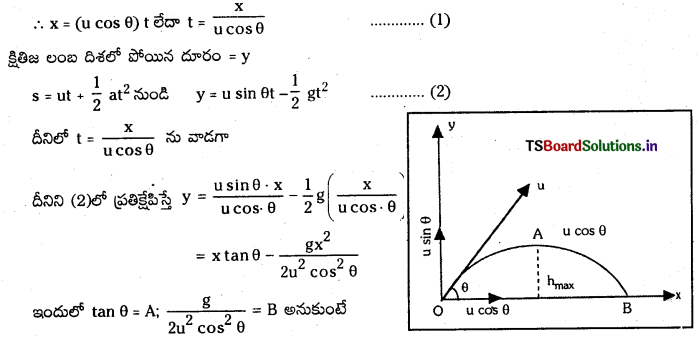
y = Ax – Bx2
ఇది ‘పరావలయ సమీకరణము.
అందువలన క్షితిజ సమాంతర దిశకు కొంత కోణంతో విసరిన వస్తువు పథం పరావలయం.
ప్రశ్న 7.
సగటు వేగం, తాక్షణిక వేగం పదాలను వివరించండి. ఈ రెండు ఎప్పుడు సమానం అవుతాయి ?
జవాబు:
సగటు వేగము : వస్తువు స్థానభ్రంశానికి, ఆ స్థాన భ్రంశానికి పట్టిన కాలవ్యవధికి గల నిష్పత్తిని వస్తువు సరాసరి లేదా సగటు వేగము అంటారు.
సగటు వేగము V = \(\frac{\Delta r}{\Delta t}=\frac{\Delta x \bar{i}+\Delta y \hat{j}}{\Delta t}\)
∴ సగటు వేగము \(\frac{\Delta \mathrm{x}_{\mathbf{i}}}{\Delta \mathrm{t}}+\frac{\Delta \mathrm{yj}}{\Delta \mathrm{t}}\)
తాక్షణిక వేగము : కాలవ్యవధి అతితక్కువగా ఉన్నపుడు అనగా శూన్యాన్ని సమీపించేటంత చిన్నదైనపుడు వస్తువు స్థానభ్రంశం మరియు కాలముల నిష్పత్తిని తాక్షణిక వేగం అంటారు.
\({Lt}_{\Delta \mathrm{t} \rightarrow 0} \frac{\Delta \mathrm{r}}{\Delta \mathrm{t}}=\frac{\mathrm{dr}}{\mathrm{dt}}\) = V తాక్షణిక వేగము
కాలవ్యవధులు అత్యల్పంగా తీసుకొనినపుడు వస్తువు తాక్షణిక వేగము మరియు ఆ కాలంలో సగటు వేగము సమానమవుతాయి.

ప్రశ్న 8.
ప్రక్షేపకం యొక్క గరిష్టోన్నతి మరియు గరిష్ఠ వ్యాప్తులు వరుసగా \(\frac{u^2 \sin ^2 \theta}{2 g}\) మరియు \(\frac{\mathrm{u}^2 \sin 2 \theta}{g}\) అని చూపండి. ఇక్కడ వాడిన పదాలు సాధారణంగా ఉపయోగించే అర్థంలోనే వాడాము.
గమనిక : ఈ ప్రశ్నను ఇంగ్లీషు మీడియమ్ టెక్స్ట్బుక్ ప్రకారం ఇవ్వడం జరిగింది. తెలుగు మీడియమ్ ప్రశ్న వేరే విధంగా ఉంది.
జవాబు:
ఏదైనా వస్తువును ‘u’ అను తొలివేగంతో క్షితిజ సమాంతరానికి ‘θ’ అను కోణంతో గాలిలోనికి విసరినామనుకొనుము. తొలివేగము ux = u cos θ ; y-దిశలో తొలివేగము uy = u sin θ
గరిష్లోన్నతి (hmax) : ప్రక్షిప్త వస్తువు క్షితిజ లంబవేగాంశము సున్న అయ్యేవరకు వస్తువు పైకి పోయిన ఎత్తును దాని గరిస్త్రోన్నతిగా నిర్వచించినారు.
త్వరణము a = − g
తొలి వేగము uy = u sin θ
v2 – u2 = 2as అను సమీకరణం నుండి
0 – u2 sin2 θ = – 2 ghmax
∴ గరిష్లోన్నతి hmax = \(\frac{u^2 \sin ^2 \theta}{2 g}\)
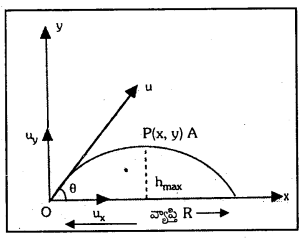
క్షితిజ సమాంతర వ్యాప్తి (R) :
వస్తువు పలాయన కాలం (T) లో ప్రయాణించిన క్షితిజ సమాంతర దూరాన్ని వ్యాప్తిగా నిర్వచించినారు.
x-దిశలో తొలివేగము ux = u cos θ;
పలాయన కాలము T = \(\frac{2 u \sin \theta}{g}\)
xదిశలో వేగము మారదు కావున వ్యాప్తి R = ux × T = \(\frac{u \cos \theta \cdot 2 u \sin \theta}{g}=\frac{u^2 2 \sin \theta \cos \theta}{g}=\frac{u^2 \sin 2 \theta}{g}\)
∴ క్షితిజ సమాంతర వ్యాప్తి R = \(\frac{\mathrm{u}^2 \sin 2 \theta}{\mathrm{g}}\)
ప్రశ్న 9.
ఒక నిర్దేశ చట్రంలో వస్తువు ప్రక్షిప్త పథం పరావలయం అయితే, ఈ నిర్దేశ చట్రంతో సాపేక్షంగా స్థిరవేగంతో -కదులుతున్న మరొక నిర్దేశ చట్రంలో కూడా వస్తువు పథం పరావలయ ఆకృతిలో ఉంటుందా ? ఒకవేళ ప్రక్షేపక పథం పరావలయం కాకపోతే అది ఏ ఆకృతిలో ఉంటుంది ?
జవాబు:
దత్తాంశం నుండి ఒక నిర్దేశ చట్రంలో వస్తువు గమనపథము పరావలయము.
రెండవ నిర్దేశ చట్రము మొదటి దానితో సాపేక్షంగా స్థిరవేగంతో చలిస్తున్నది. అనగా ఆ రెండు చట్రముల మధ్య త్వరణము సున్న. కేవలం ఆ రెంటి మధ్య కొంత దశాబేధం ఉంటే వుండవచ్చు. ఈ పరిస్థితులలో ఆ రెండు చట్రాలు ఒకేరకమైన నిర్దేశ చట్రాలను కలిగి ఉంటాయి. ఆ రెండు (1) జడత్వ నిర్దేశ చట్రంలో ఉండవచ్చు లేదా ఆ రెండు (2) సమానమైన త్వరణ నిర్దేశచట్రంలో ఉండవచ్చు. ఎందుకనగా సాపేక్ష త్వరణము సున్నకావున.
పై వివరణను బట్టి ఆ రెండు వ్యవస్థలు ఒకే రకమైన నిర్దేశ చట్రంలో వున్నాయి. తుల్యతా నియమం ప్రకారము ఒకేరకమైన వ్యవస్థలో జరిపిన ప్రయోగాలు ఒకేరకమైన ఫలితాన్ని ఇస్తాయి. కావున మొదటి నిర్దేశక చట్రంలో వస్తువు గమనము పరావలయమైతే రెండవ నిర్దేశ చట్రంలో కూడా దాని గమనపథము పరావలయమే అవుతుంది.

ప్రశ్న 10.
నిశ్చలస్థితిలో ఉన్న వస్తువుపై 2i + j – k న్యూటన్ల బలం పనిచేస్తుంది. 20 సెకనుల చివర వస్తువు వేగం 4i + 2j – 2k ms-1 అయితే ఆ వస్తువు ద్రవ్యరాశి ఎంత ?
జవాబు:
బలము F = 2i + j – k, కాలము t = 20
తొలి వేగము Vo = 0
తుది వేగము V = 4i + 2j – 2k
∴ త్వరణము a = \(\frac{\mathrm{V}-\mathrm{V}_0}{\mathrm{t}}=\frac{4 \mathrm{i}+2 \mathrm{j}-2 \mathrm{k}}{20}=\frac{2(2 \mathrm{i}+\mathrm{j}-\mathrm{k})}{10}\)
వస్తువు ద్రవ్యరాశి m = \(\frac{F}{a}=\frac{2 i+j-k}{(2 i+j-k) / 10}\) = 10 కి.గ్రా.
లెక్కలు
ప్రశ్న 1.
ఓడ B కి ఓడ A పశ్చిమ దిశలో 10 km దూరంలో ఉంది. ఓడ A నేరుగా ఉత్తర దిక్కువైపు 30 km/h వడితో వెళు తుంటే, ఓడ B ఉత్తర దిశతో పడమరవైపు 60° కోణం చేస్తూ 20 km/h వడితో వెళుతుంది.
(i) ఓడ A కి సాపేక్షంగా ఓడ B వేగ పరిమాణాన్ని, దిశను కనుక్కోండి.
(ii) రెండింటి మధ్య అత్యంత సమీప దూరం (closest approach) ఎంత ?
సాధన:
A వేగము = 30 kmph ఉత్తరం వైపు ∴VA = 30j
B వేగము = 20 kmph 60° పశ్చిమ దిశ నుండి ఉత్తరం వైపు
∴ VB = -20sin60° + 20 cos 60° = \(10 \sqrt{3} \hat{\mathrm{i}}+10 \hat{\mathrm{j}}\)
A తో పోల్చితే B వేగము = VB – VA = -10\(\sqrt{3} \hat{\mathrm{i}}+10 \hat{\mathrm{j}}-30 \hat{\mathrm{j}}\)
= -10\(\sqrt{3} \hat{\mathrm{i}}-20 \hat{\mathrm{j}}\)
VR = | VB – VA|= \(\sqrt{100 \times 3+400}\) = 10\(\sqrt{7}\) kmph.
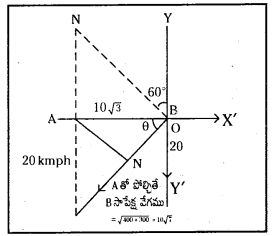
అతి తక్కువ దూరము :
త్రిభజం ABN నుండి అతి తక్కువ దూరము AN = AB sin θ
కాని AB = 10 km
∴ AN = 10 × \(\frac{20}{10 \sqrt{7}}=\frac{20}{\sqrt{7}}\) = 7.56 km

ప్రశ్న 2.
ప్రక్షేపక కోణం Q, వ్యాప్తి R, గరిష్ఠ ఎత్తు h, ప్రయాణ కాలం T అయితే
a) tan α = 4h/R,
(b) h = gT2 / 8 అని చూపండి.
సాధన:
(a) ప్రక్షేపక కోణము = θ, వ్యాప్తి, R = \(\frac{\mathrm{u}^2 \sin 2 \theta}{\mathrm{g}}\)
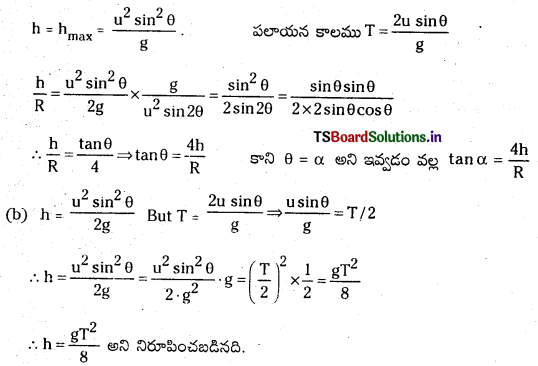
ప్రశ్న 3.
క్షితిజ సమాంతరంతో 60° కోణం చేస్తూ 800 m/s తొలి వేగంతో ఒక ప్రక్షేపకాన్ని పేల్చారు :
(i) భూమిని తాకే ముందు ప్రక్షేపకం ప్రయాణ కాలం కనుక్కోండి.
(ii) అది భూమిని తాకే ముందు ప్రయాణించిన దూరాన్ని (వ్యాప్తి) కనుక్కోండి.
(iii) గరిష్ఠ ఎత్తుకు చేరుకోడానికి పట్టే ప్రయాణ కాలాన్ని కనుక్కోండి.
సాధన:
ప్రక్షేపక కోణము θ = 60°, తొలివేగము, U = 800 m/s

iii) గరిష్టోన్నతి చేరటానికి పట్టిన కాలము = \(\frac{\mathrm{T}}{2}\)
T1 = \(\frac{2 \mathrm{u} \sin \theta}{2 \mathrm{~g}}=\frac{\mathrm{u} \sin \theta}{\mathrm{g}}=\frac{800 \sin 60^{\circ}}{9.8}\)
= \(\frac{800 \times 0.8660}{9.80}\) = 70.7 sec

ప్రశ్న 4.
భూమికి ఏటవాలుగా ప్రక్షిప్తం చేసిన కణం తన పథంలో గరిష్ఠ బిందువు దగ్గర ఉన్నప్పుడు ప్రక్షేపణ బిందువు దృష్ట్యా దాని స్థాన సదిశ పరిమాణం అది చేరుకొనే గరిష్ఠ ఎత్తుకు \(\sqrt{2}\) రెట్లు ఉన్నట్లయితే ప్రక్షేపక కోణం tan-1(2) అని చూపండి.
సాధన:
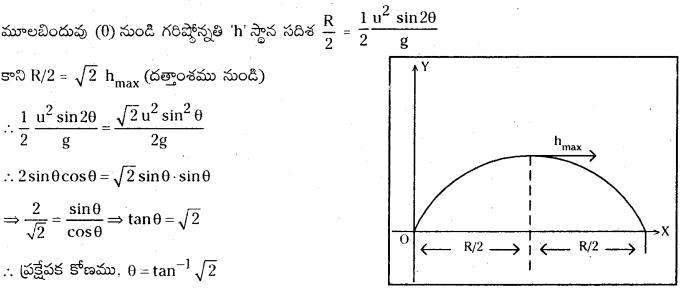
ప్రశ్న 5.
భూమికి 20 m ఎత్తున ఉన్న శిఖరంపై నుంచి వస్తువును క్షితిజ సమాంతరానికి 30° కోణంతో 30m/s తొలివేగంతో ప్రయోగించారు. భూమిపై దిగే ముందు క్షితిజ సమాంతరంగా వస్తువు ఎంత దూరం ప్రయాణిస్తుంది ? (g = 10 m/s2)
సాధన:
శిఖరం ఎత్తు = 20m
ప్రక్షేపక కోణము, θ = 30°
ప్రక్షేపక వేగము, u = 30 m/s
క్షితిజ సమాంతరదిశలో ప్రయాణించిన మొత్తం దూరము = OC = OB’ + B’C
(a)కాని OB’ = AB = వ్యాప్తి R = \(\frac{\mathrm{u}^2 \sin 2 \theta}{\mathrm{g}}\)
∴ R = \(\frac{30 \times 30 \sin 60^{\circ}}{10}=90 \frac{\sqrt{3}}{2}=45 \sqrt{3}\) …………… (1)
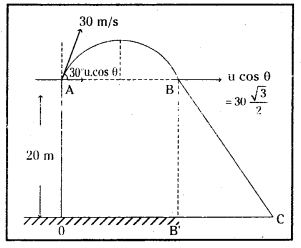
(b)దూరము B’C = క్షితిజ సమాంతర ప్రక్షేపకం వ్యాప్తి
∴ వ్యాప్తి = u cos θ t
u. cos θ = 30 . \(\frac{\sqrt{3}}{2}=15 \sqrt{3}\)
భూమిని తాకుటకు పట్టినకాలము, t = ?
దత్తాంశం నుండి Sy = 20, uy = u sin θ = 30 sin 30° = 15 m/s
∴ Sy = 20 = 15 t + \(\frac{10}{2}\) t2 ⇒ 5t2 + 15t – 20 = 0
లేదా t2 + 3t – 4 = 0 లేదా (t + 4) (t – 1) = 0
∴ t = – 4 లేదా t = 1 ∴ t ఋణాత్మకంగా ఉండదు కావున t = 1 అగును.
∴ వ్యాప్తి = 4 . cos θ . t = 15\(\sqrt{3}\) …………… (2)
భూమిపై దిగే ముందు క్షితిజ సమాంతరంగా వస్తువు ప్రయాణించిన మొత్తం దూరం = 45\(\sqrt{3}\) + 15\(\sqrt{3}\) = 60\(\sqrt{3}\) m.

ప్రశ్న 6.
నేలపై ౦ బిందువును మూల బిందువుగా తీసుకోవడమైంది. ఒక వస్తువు ముందు ఈశాన్య (North-East) దిశలో 10\(\sqrt{2}\) m స్థానభ్రంశాన్ని, ఆ తరవాత ఉత్తర దిశలో 10 m, పిమ్మట 10\(\sqrt{2}\) m వాయువ్య దిశలో పొందింది. మూల బిందువు నుంచి అది ఎంత దూరంలో ఉంది ?
సాధన:
a) 10\(\sqrt{2}\) m ఈశాన్య దిశ
b) 10m ఉత్తర దిశ
c) 10\(\sqrt{2}\) m వాయువ్య దిశ
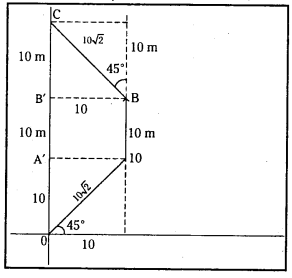
పటములో మూలబిందువు ‘O’ నుండి మొత్తం స్థానభ్రంశము = OC
కాని OC = OA’ + A’B’ + B’C = 10 + 10 + 10 = 30m.
ప్రశ్న 7.
భూమిపై ఒక బిందువు నుంచి తొలి వేగం తో కణాన్ని క్షితిజ సమాంతర వ్యాప్తి గరిష్ఠం అయ్యే విధంగా ప్రక్షిప్తం చేశారు. దాని ఆరోహణ క్రమంలో (ascent) ఉండే సగటు వేగం పరిమాణాన్ని కనుక్కోండి.
సాధన:
ప్రక్షేపక వేగము : = u.
వ్యాప్తి గరిష్ఠము ⇒ θ = 45°
ఆరోహణ కాలంలో అనగా h = hmax ⇒ ux = vx = u . cos θ
సగటు వేగము, VA = \(\sqrt{v_{\mathrm{x}}^2+v_{\mathrm{y}}^2}\)
Vx = x-దిశలో సగటు వేగము = \(\frac{\mathrm{u} \cdot \cos \theta+\mathrm{u} \cos \theta}{2}\)
vx = u . cos θ = u – cos 45° = u/\(\sqrt{2}\) …………….. (1)
y-దిశలో సగటు వేగము = \(\frac{\mathrm{u}_{\mathrm{y}}+\mathrm{v}_{\mathrm{y}}}{2}\)
uy = u sinθ = u/latex]\sqrt{2}[/latex], vy = 0 (hmax వద్ద)
∴ vy = \(\frac{u / \sqrt{2}}{2}=\frac{u}{2 \sqrt{2}}\) …………….. (2)
ఆరోహణ కాలంలో సగటు వేగము = \(\sqrt{\left(\frac{u}{\sqrt{2}}\right)^2+\left(\frac{u}{2 \sqrt{2}}\right)^2}\)
సరాసరి వేగము = \(\sqrt{\frac{u^2}{2}+\frac{u^2}{4 \times 2}}=\sqrt{\frac{4 u^2+u^2}{8}}=\frac{u \sqrt{5}}{2 \sqrt{2}}\)

ప్రశ్న 8.
భూమిపై నుంచి ఒక కణాన్ని కొంత తొలివేగంతో క్షితిజ సమాంతరానికి 45° కోణంతో ప్రక్షిప్తం చేశారు. అది క్షితిజ సమాంతరంగా 10m దూరం ప్రయాణించేంతలో, భూమి నుండి 7.5 m ఎత్తుకు చేరుతుంది. ప్రక్షేపకం తొలి వడి ఎంత? (g = 10 m/s2)
సాధన:
ప్రక్షేపక కోణము = 45°
నిలువు దిశలో ఎత్తు, hy = 7.5 m
క్షితిజ సమాంతర దూరము, hx = 10 m
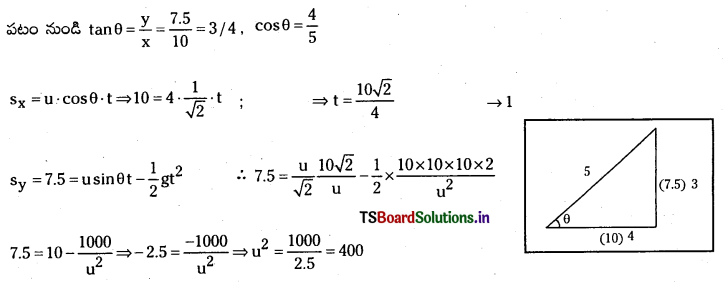
u2 = 400 ⇒ u = 20m/s
ప్రశ్న 9.
దక్షిణ దిశ నుంచి 5 ms-1 వేగంతో గాలి వీస్తుంది. ఒక సైకిల్ తొక్కే వ్యక్తికి అది 5 ms-1 వేగంతో తూర్పు దిశ నుంచి వీస్తుందనిపిస్తుంది. సైకిల్ తొక్కే వ్యక్తి ఈశాన్య దిశలో 5\(\sqrt{2}\) ms-1 వేగంతో ప్రయాణిస్తున్నాడని చూపించండి.
సాధన:

- గాలి వేగము పక్షిణం నుండి ఉత్తరం వైపు 5 m/s
- వ్యక్తి భావించిన వేగము = సాపేక్ష వేగము = 5 m/s తూర్పు నుండి
- సైకిలిష్ట్ వేగము కనుక్కోవటానికి ఫలిత సదిశను వెనుకకు తిప్పి మరల ఫలిత సదిశ కనుక్కోవలె.
∴ సైకిలిష్ట్ వేగము = \(\sqrt{5^2+5^2+0}\) = 5\(\sqrt{2}\) m/s

ప్రశ్న 10.
4m/s తో నడుస్తున్న మనిషి వాన బిందువులు ఏటవాలుగా తన ముఖంపై 4 m/s వడితో నిట్టనిలువుగా 30° కోణం చేస్తూ పడుతున్నాయని గమనించాడు. వాన బిందువు వాస్తవ వడి 4 m/s అని చూపండి.
సాధన:
మనిషి వేగము = 4 m/sec
వాన చినుకులను గమనించిన వేగము = 4 m/sec
క్షితిజలంబముతో 30°. ఇది సాపేక్ష వేగము
a) మనిషి వేగము = \(4 \hat{\mathrm{i}}\)
వాన చినుకుల వేగము = 4 m/s, 30° (లంబముతో)
∴ ఈ వేగాన్ని = – 4 sin 30 i – 4 . cos 30° \(\hat{\mathrm{j}}\) తో సూచిస్తారు.
= -4\(\frac{1}{2} \hat{\mathrm{i}}+4 \frac{\sqrt{3}}{2}\) అనుకోండి. VR = -2\(\hat{\mathrm{i}}+2 \sqrt{3} \hat{\mathrm{j}}\)
కాని VR = VB – VA ఇందులో VB వాన చినుకుల నిజవేగము
VB – VA + VA = VB = –\(2 \hat{\mathrm{i}}+2 \sqrt{3} \hat{\mathrm{j}}+4 \hat{\mathrm{i}}=2 \hat{\mathrm{i}}+2 \sqrt{3} \hat{\mathrm{j}}\)
|VB|= \(\sqrt{4+4 \times 3}=\sqrt{16}\) = 4 m/s
ముఖ్యమైన ఉదాహరణ లెక్కలు
ప్రశ్న 1.
35 ms-1 వడితో వాన నిట్టనిలువుగా పడుతోంది. కొంతసేపటి తరువాత 12 ms-1 వడితో గాలి తూర్పు నుంచి పడమర దిశగా వీచడం ప్రారంభించింది. బస్ స్టాప్లో వేచి ఉన్న బాలుడు వాన మీద పడకూడదు అంటే గొడుగును ఏ దిశలో పట్టుకోవాలి ?

సాధన:
పటంలో వాన, గాలి వేగ సదిశలను వరుసగా vr, vw లతో సమస్యలో ఇచ్చిన దిశలో చూపించడమైనది. సదిశల సంకలన నియమం ద్వారా vr, v2 ల ఫలిత సదిశ R పటంలో చూపిన విధంగా ఉంటుంది. R పరిమాణాన్ని కింది విధంగా లెక్కించవచ్చు.
R = \(\sqrt{v_{\mathrm{r}}^2+v_w^2}=\sqrt{35^2+12^2}\) ms-1 = 37 ms-1
నిట్టనిలువుతో ఫలిత సదిశ R చేసే కోణం 9 ను కింది విధంగా రాయవచ్చు.
tan θ = \(\frac{v_w}{v_r}=\frac{12}{35}\) = 0.343
లేదా θ. = tan-1 (0.343) = 19°
కాబట్టి, నిట్టనిలువు తలంలో తూర్పుదిశకు 19° చేసే విధంగా గొడుగు పట్టుకొని నిలబడాలి.

ప్రశ్న 2.
ఒక మోటారు బోటు ఉత్తర దిశవైపు 25 km/h వేగంతో దూసుకుపోతోంది. అక్కడ నీటి ప్రవాహం 10 km/h వేగం కలిగి దక్షిణం దిశతో 60° కోణం చేస్తూ తూర్పువైపుకు ఉంది. బోటు ఫలితవేగాన్ని కనుక్కోండి.
సాధన:
మోటారు బోటు వేగాన్ని vb తో, నీటి ప్రవాహవేగాన్ని vc/sub> తో సమస్యలో ఇచ్చిన దిశలలో పటంలో చూపించడమైంది.
సమాంతర చతుర్భుజ సంకలన నియమం ప్రకారం ఫలిత సదిశ R దిశ పటంలో చూపించిన విధంగా ఉంటుంది. కొసైన్ల న్యాయం ప్రకారం R పరిమాణాన్ని కింది విధంగా రాబట్టవచ్చు.
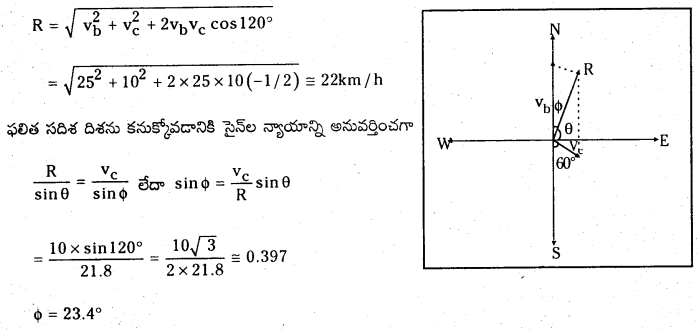
ప్రశ్న 3.
ఒక కణం స్థానాన్ని \(3.0 t \hat{i}+2.0 t^2 \hat{j}+5.0 \hat{k}\) సూచిస్తుంది. ఇక్కడ t సెకనులలో, మీటర్లలో ఉండే విధంగా గుణకాలు సరైన ప్రమాణాలను కలిగి ఉన్నాయి. కణం యొక్క (a) v(t), a(t) లను కనుక్కోండి. (b) t = 1.0 s వద్ద v(t) పరిమాణం, దిశను కనుక్కోండి.
సాధన:


ప్రశ్న 4.
కాలం t = 0 వద్ద మూలబిందువు దగ్గర నుంచి బయలుదేరిన కణం 5.0\(\hat{\mathrm{i}}\)m/s వేగంతో x-y తలంలో ప్రయోగించిన బలం వల్ల స్థిర త్వరణం (\(3.0 \hat{\mathrm{i}}+2.0 \hat{\mathrm{j}}\))m/s2 పొంది చలిస్తుంది. (a) x-నిరూపకం 84 m అయినప్పుడు కణం y-నిరూపకం ఎంత ? ఈ కాలం వద్ద కణం వడి ఎంత ?
సాధన:
కణం స్థానాన్ని కింది విధంగా రాయవచ్చు.
r (t) = vot + \(\frac{1}{2}\) at2
= \(5.0 \hat{\mathrm{i}} \mathrm{t}+(1 / 2)(3.0 \hat{\mathrm{i}}+2.0 \hat{\mathrm{j}}) \mathrm{t}^2\)
= \(\left(5.0 \mathrm{t}+1.5 \mathrm{t}^2\right) \hat{\mathrm{i}}+1.0 \mathrm{t}^2 \hat{\mathrm{j}}\)
కాబట్టి, x(t) = 5.0 t + 1.5 t2
y(t) = + 1.0t2
x(t) = 84 m గా ఇచ్చారు. అప్పుడు, t = ?
5.0 t + 1.5 t2 = 84 ⇒ t = 6s
t = 6 s అయినప్పుడు, y = 1.0 (6)2 = 36.0 m
ఇప్పుడు వేగం v = \(\frac{\mathrm{dr}}{\mathrm{dx}}\) (5.0 + 3.0 t) \(\hat{\mathrm{i}}+2.0 \mathrm{t} \hat{\mathrm{j}}\)
t = 6 s అయినపుడు, v = 23.0 \(23.0 \hat{\mathrm{i}}+12.0 \hat{\mathrm{j}}\)
వడి = | v | = \(\sqrt{23^2+12^2}\) ≅ 26 ms-1.
ప్రశ్న 5.
వాన నిట్టనిలువుగా 35 ms-1 వడితో పడుతోంది. ఒక మహిళ 12 ms-1 వేగంతో తూర్పు నుండి పశ్చిమ దిశలో సైకిల్పై వెళుతుంది. ఆమె ఏ దిశలో గొడుగును పట్టుకోవాలి ?
సాధన:
పటంలో vr వాన వేగాన్ని, vb మహిళ తొక్కుతున్న సైకిల్ వేగాన్ని సూచిస్తాయి. ఈ రెండు వేగాలు కూడా భూమి దృష్ట్యానే. మహిళ సైకిల్ తొక్కుతుంది. కాబట్టి, ఆమె దృష్ట్యా వాన వేగం, అంటే సైకిల్ వేగానికి సాపేక్షంగా వాన వేగం అని అర్థం. అంటే vrb = vr – vb
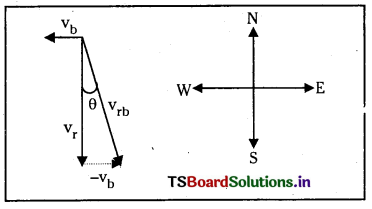
ఈ సాపేక్ష వేగం సదిశ పటంలో చూపినట్లు నిట్టనిలువుతో θ కోణం చేస్తుంది.
tan θ = \(\frac{\mathrm{v}_{\mathrm{b}}}{\mathrm{v}_{\mathrm{r}}}=\frac{12}{35}\) = 0.343
లేదా θ ≅ 19°
అంటే మహిళ పడమర దిశలో నిట్టనిలువుతో 19° కోణం చేస్తూ గొడుగును పట్టుకోవాలి.
ప్రశ్న 6.
భూమికి 490 m ఎత్తున ఉన్న శిఖరం పైనుంచి ఒక పర్వతారోహకుడు రాయిని 15 m s-1 తొలివేగంతో క్షితిజ సమాంతరంగా విసిరాడు. గాలి నిరోధాన్ని ఉపేక్షించి, రాయి నేలను తాకేందుకు పట్టే కాలాన్ని, అది నేలను తాకే వేగాన్ని కనుక్కోండి. (g = 9.8 m s-2 గా తీసుకోండి).
సాధన:
శిఖర శీర్షాన్ని మూల బిందువుగా తీసుకొని x-, y-అక్షాలను ఊహించండి. రాయిని t = 0 s వద్ద విసిరాడు అనుకొందాం. తొలి వేగం దిశలో ధన X అక్షం దిశ, నిట్టనిలువు ఊర్ధ్వదిశలో ధన y అక్షం దిశ ఉందనుకొందాం. x-, y-చలన అంశాలను స్వతంత్ర అంశాలుగా పరిగణించవచ్చు. ఇప్పుడు చలన సమీకరణాలు :
x(t) = x0 + v0xt
y(t) = y0 + voyt + (1/2)ayt2
ఇక్కడ, x0 = y0 = 0, v0y = 0, ay = -g = -9.8 ms-2
v0x = 15 ms-1.
y(t) = -490 m అయినప్పుడు రాయి నేలను తాకుతుంది.
– 490 m = – (1/2) (9.8) t2. దీనిని సాధించగా, t = 10 s,
వేగాంశాలు vx = v0x, vy = v0y – g t
రాయి నేలను తాకే సందర్భంలో :
v0x = 15 m s-1 ; v0y = 0 – 9.8 × 10 = -98 m s-1
కాబట్టి, నేలను రాయి తాకే వడి
\(\sqrt{v_{\mathrm{x}}^2+v_{\mathrm{y}}^2}=\sqrt{15^2+98^2}\) = 99 ms-1

ప్రశ్న 7.
క్షితిజ సమాంతరంతో 30° కోణం చేస్తూ ఒక క్రికెట్ బంతిని 28 m s-1 వేగంతో విసిరారు. కింది వాటిని లెక్కించండి. (a) గరిష్ఠ ఎత్తు, (b) బంతి తిరిగి అదే స్థాయికి రావడానికి పట్టే కాలం, (c) బంతి విసిరిన స్థానం నుంచి బంతి తిరిగి అదే స్థాయికి చేరిన స్థానానికి మధ్య దూరం.
సాధన:
(a) గరిష్ఠ ఎత్తు
hm = \(\frac{\left(\mathrm{v}_0 \sin \theta_0\right)^2}{2 \mathrm{~g}}=\frac{\left(28 \sin 30^{\circ}\right)^2}{2(9.8)} \mathrm{m}\)
= \(\frac{14 \times 14}{2 \times 9.8}\) = 10.0 m
(b) బంతి తిరిగి అదే స్థాయికి రావడానికి పట్టిన కాలం (2 v0 sin θ0)/g = (2 × 28 × sin 30°) / 9.8
= 28/9.8s = 2.9s
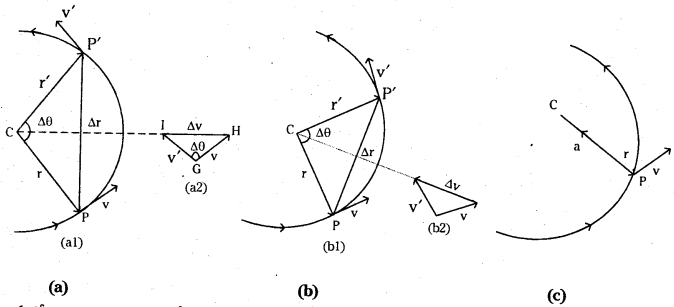
ఏకరీతి వృత్తాకార చలనంలో వున్న వస్తువు వేగం, త్వరణం. కాలవ్యవధి ∆t (a) నుంచి (c) వరకు తగ్గుతూ వచ్చి c వద్ద శూన్యం అయింది. పథంలో ప్రతి బిందువు దగ్గర వున్న త్వరణం వృత్త కేంద్రం వైపు వుంటుంది.
(c) బంతి విసిరిన స్థానం నుంచి బంతి తిరిగి అదే స్థాయికి చేరిన స్థానానికి మధ్య దూరం
R = \(\frac{\left(v_{\mathrm{o}}^2 \sin 2 \theta_{\mathrm{o}}\right)}{g}=\frac{28 \times 28 \times \sin 60^{\circ}}{9.8}\) = 69 m

ప్రశ్న 8.
12cm వ్యాసార్ధం ఉన్న వృత్తాకార గాడిలో ఇరుక్కొన్న కీటకం 100s కాలంలో నిలకడగా 7 పరిభ్రమణాలు పూర్తి చేసింది. (a) కీటకం కోణీయ వడి, రేఖీయ వడి ఎంత ? (b) త్వరణం సదిశ స్థిర సదిశేనా ? దాని పరిమాణం ఎంత ?
సాధన:
ఏకరీతి వృత్తాకార చలనానికి ఇది ఒక ఉదాహరణ.
ఇక్కడ R = 12 cm. కోణీయ వడి ప ని ఇలా రావయచ్చు.
ω = 2πT = 2π × 7/ 100 = 0.44 rad/s
రేఖీయ వడి v :
v = ωR = 0.44s-1 × 12 cm = 5.3 cm s-1
వేగ సదిశ V వృత్తంపై ప్రతీ బిందువు వద్ద స్పర్శరేఖ దిశలో ఉంటుంది. త్వరణం వృత్తకేంద్రం వైపు ఉంటుంది. ఇక్కడ త్వరణం దిశ నిరంతరం మారుతుంది కాబట్టి స్థిర సదిశ కాదు. త్వరణం పరిమాణం మాత్రం స్థిరం.
a = ω2R = (0.44s-1)2 (12 cm) = 2.3 cm s-2
అదనపు లెక్కలు
ప్రశ్న 1.
కింద ఇచ్చిన రాశులు సదిశలా లేదా అదిశలా తెలపండి. ఘనపరిమాణం, ద్రవ్యరాశి, వడి, త్వరణం, సాంద్రత మోల్ల సంఖ్య, వేగం, కోణీయ పౌనఃపున్యం, స్థానభ్రంశం, కోణీయ వేగం.
సాధన:
అదిశ రాశులు : ఘనపరిమాణము, ద్రవ్యరాశి, వడి, సాంద్రత, మోల్ల సంఖ్య, కోణీయ పౌనఃపున్యము.
సదిశ రాశులు : త్వరణము, వేగము, స్థానభ్రంశము, కోణీయ వేగము.
ప్రశ్న 2.
కింద ఇచ్చిన జాబితాలో రెండు అదిశరాశులను ఎంపిక చేయండి. బలం, కోణీయ ద్రవ్యవేగం, పని, విద్యుత్ ప్రవాహం, రేఖీయ ద్రవ్యవేగం, విద్యుత్ క్షేత్రం, సగటు వేగం, అయస్కాంత భ్రామకం, సాపేక్ష వేగం.
సాధన:
ఇచ్చిన వాటిలో పని మరియు విద్యుత్ ప్రవాహము అదిశరాశులు.
ప్రశ్న 3.
కింద ఇచ్చిన జాబితాలో సదిశరాశి ఉన్నది. దానిని ఎంపిక చేయండి. ఉష్ణోగ్రత, పీడనం, ప్రచోదనం, కాలం, సామర్థ్యం, మొత్తం పథం పొడవు, శక్తి, గురుత్వ పొటెన్షియల్, ఘర్షణ గుణకం, విద్యుదావేశం.
సాధన:
ఇచ్చిన వాటిలో సదిశరాశి ప్రచోదనము. ఇది బలము మరియు కాలముల లబ్ధము. ఇది ద్రవ్యవేగంలో మార్పుకు సమానము కావున సదిశరాశి.
ప్రశ్న 4.
కింది ఇచ్చిన సదిశ, అదిశ రాశుల మధ్య జరిగే బీజగణిత పరిక్రియలు అర్థవంతమైనవో, కావో కారణాలతో వివరించండి.
(a) ఏవైనా రెండు అదిశల సంకలనం,
(b) ఒకే మితులు ఉన్న అదిశను సదిశకు సంకలనం చేయడం,
(c) ఏదైనా సదిశను ఏదైనా అదిశతో గుణించడం,
(d) ఏవైనా రెండు అదిశలను గుణించడం,
(e) ఏవైనా రెండు సదిశలను సంకలనం చేయడం,
(f) ఒక సదిశ అంశాన్ని అదే సదిశకు సంకలనం చేయడం.
సాధన:
a) సరి అయినది కాదు. ఎందుకనగా ఒకే మితి కలిగిన అదిశలను మాత్రమే సంకలనము చేయవలెను.
b) సరి అయినది కాదు. అదిశలను సదిశలకు కలపడం సాధ్యపడదు. ఎందుకనగా సంకలనం సజాతిరాశుల మధ్య మాత్రమే జరుగును.
c) సరి అయినది. సదిశలను అదిశతో గుణించవచ్చు.
ఉదా : త్వరణము × ద్రవ్యరాశి = బలము
d) సరి అయినది. రెండు అదిశలను గుణించడం సరి అయినది.
ఉదా : పని = సామర్థ్యము × కాలము
e) సరి అయినది కాదు : కేవలం ఒకే మితి గల సదిశలను మాత్రమే సంకలనం చేయగలము.
f) సరి అయినది. ఎందుకనగా రెండు సదిశలు ఒకే మితిని కలిగి ఉన్నాయి కావున.

ప్రశ్న 5.
కింద ఇచ్చిన ప్రవచనాలను జాగ్రత్తగా చదివి కారణాలతో అవి తప్పా లేదా ఒప్పా తెలియచేయండి.
(a) సదిశ పరిమాణం ఎప్పుడూ అదిశే,
(b) సదిశ ప్రతీ అంశం ఎప్పుడూ అదిశే,
(c) మొత్తం పథం పొడవు ఎప్పుడూ కణం స్థానభ్రంశ సదిశ పరిమాణానికి సమానం,
(d) కణం సగటు వడి (మొత్తం పథ దూరాన్ని ఆ పథాన్ని పూర్తిచేయడానికి పట్టేకాలంతో భాగించగా వచ్చే రాశి) అదే కాలవ్యవధిలో కణం సగటు వేగం పరిమాణం కంటే ఎక్కువ లేదా సమానంగా ఉంటుంది.
(e) ఒకే తలంలో లేని మూడు సదిశలు కలిసి ఎప్పుడూ శూన్య సదిశను ఇవ్వలేవు.
సాధన:
a) సరి అయినది. ఎందుకనగా పరిమాణం ఒక సంఖ్య మాత్రమే.
b) సరి అయినది కాదు. ఎందుకనగా సదిశ ప్రతి అంశం మరల సదిశ కావున.
c) నిజమైనది. ఇచ్చిన వస్తువు సరళరేఖ వెంబడి అదే దిశలో చలిస్తుంది. ఈ ప్రవచనము సరి అయినది.
d) నిజమైనది. పథం పొడవు స్థానభ్రంశానికన్నా ఎక్కువ లేదా సమానంగా ఉండవచ్చు.
e) నిజమైనది. ఎందుకనగా ఈ మూడు సదిశలు కలసి ఒక సమతలంలో గల త్రిభుజాన్ని ఏర్పరచలేవు కావున.
ప్రశ్న 6.
రేఖాచిత్ర పట పద్ధతి లేదా ఇతర పద్ధతిలో కింద ఇచ్చిన సదిశా అసమానతలను రుజువు చేయండి :
a) \(|\overrightarrow{\mathrm{A}}+\overrightarrow{\mathrm{B}}| \leq|\overrightarrow{\mathrm{A}}|+|\overrightarrow{\mathrm{B}}|\)
b) \(|\overrightarrow{\mathrm{A}}+\overrightarrow{\mathrm{B}}| \geq|| \overrightarrow{\mathrm{A}}|-| \overrightarrow{\mathrm{B}} \mid\)
c) \(|\overrightarrow{\mathbf{A}}+\overrightarrow{\mathrm{B}}| \geq\|\overrightarrow{\mathrm{A}}|-| \overrightarrow{\mathrm{B}}\|\)
d) \(|\overrightarrow{\mathrm{A}}-\overrightarrow{\mathrm{B}}| \geq|| \overrightarrow{\mathrm{A}}|-| \overrightarrow{\mathbf{B}} \|\)
ఏ సందర్భంలో సమానత గుర్తు వర్తిస్తుంది ?
సాధన:
a) \(|\overrightarrow{\mathrm{A}}+\overrightarrow{\mathrm{B}}| \leq|\overrightarrow{\mathrm{A}}|+|\overrightarrow{\mathrm{B}}|\)అని చూపుట :
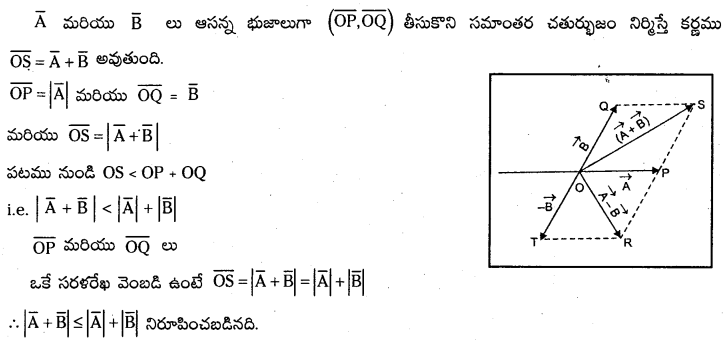

b) \(|\overrightarrow{\mathrm{A}}+\overrightarrow{\mathrm{B}}| \geq|| \overrightarrow{\mathrm{A}}|-| \overrightarrow{\mathrm{B}} \mid\) అని చూపుట :
∆OPS నుండి OS + PS > OP లేదా OS > |OP – PS| లేదా
OS > |OP – OQ| → 1 (∵ PS = OQ)
పై సమీకరణలో OS ఎల్లపుడు ధనాత్మకము కాని OP – OQ ధనాత్మకం లేదా ఋణాత్మకం కావచ్చు. OP < PS లేదా OQ అయినపుడు ∴ \(|\mathrm{OS}|=|\overline{\mathrm{A}}+\overline{\mathrm{B}}|>|\overline{\mathrm{A}}|-|\overline{\mathrm{B}}|\) → 2
\(\overline{\mathrm{A}}\) మరియు \(\overline{\mathrm{B}}\) లు వ్యతిరేక దిశలో ఒకే సరళరేఖ వెంబడి పనిచేస్తే \(|\overline{\mathrm{A}}+\overline{\mathrm{B}}|=|\overline{\mathrm{A}}|-|\overline{\mathrm{B}}|\) → 3
1, 2, 3 సమీకరణాలను కలిపితే \(|\overline{\mathrm{A}}+\overline{\mathrm{B}}| \geq|| \overline{\mathrm{A}}|-| \overline{\mathrm{B}}||\)
c) \(|\overrightarrow{\mathrm{A}}+\overrightarrow{\mathrm{B}}| \geq\|\overrightarrow{\mathrm{A}}|-| \overrightarrow{\mathrm{B}}\|\) అని చూపుట :

d) \(|\overrightarrow{\mathrm{A}}-\overrightarrow{\mathrm{B}}| \geq|| \overrightarrow{\mathrm{A}}|-| \overrightarrow{\mathrm{B}} \|\) అని చూపుట :
పటములోని OPR త్రిభుజం నుండి OR + PR > OP లేదా
OR > |OP – PR| లేదా OR > | OR – OT| → 6 (∵ OT= PR)
పై సమీకరణలో L.H.S. వైపు గల OP ధనాత్మకము కాని OP – OT
ధనాత్మకము లేదా ఋణాత్మకము
∴ \(\overline{\mathrm{OR}}=|\overline{\mathrm{A}}-\overline{\mathrm{B}}|>|\overline{\mathrm{A}}|-\mid \overline{\mathrm{B}} \|\)→ 7
సదిశలు \(\overline{\mathrm{A}}\) మరియు \(\overline{\mathrm{B}}\) లు ఒకే సరళరేఖ వెంబడి ఒకే దిశలో పనిచేస్తే \(|\overline{\mathrm{A}}-\overline{\mathrm{B}}| \geq|| \overline{\mathrm{A}}|-| \overline{\mathrm{B}}||\)
6, 7 నియమాల నుండి \(|\overline{\mathrm{A}}-\overline{\mathrm{B}}| \geq|| \overline{\mathrm{A}}|-| \overline{\mathrm{B}}||\)
ప్రశ్న 7.
a + b + c + d = 0 అని ఇచ్చారు. కింది ప్రవచనాలలో ఏది సరియైనది :
a) a, b, c, d లలో ప్రతీది శూన్య సదిశ,
b) (a + c) పరిమాణం (b + d) పరిమాణానికి సమానం,
c) సదిశ a పరిమాణం ఎప్పుడూ b, c, d ల మొత్తం పరిమాణం కంటె అధికం కాదు.
d) a, d లు ఏకరేఖీయాలు కానప్పుడు b + c, a, d ఉండే తలంలోనే ఉండాలి. అవి ఏక రేఖీయాలు అయితే a, d లకు రేఖీయంగా ఉండాలి.
సాధన:
a) సరి అయినది కాదు. ఎందుకనగా \(\overline{\mathrm{a}}+\overline{\mathrm{b}}+\overline{\mathrm{c}}+\overline{\mathrm{d}}\) లను ఇచ్చిన ప్రవచనం ప్రకారమే కాకుండా అనేక విధాలుగా సున్నకు సమానం చేయవచ్చు.
b) సరి అయినది. ఎందుకనగా \(\overline{\mathrm{A}}+\overline{\mathrm{B}}+\overline{\mathrm{C}}+\overline{\mathrm{D}}\) = 0 ఐతే \(\overline{\mathrm{A}}+\overline{\mathrm{C}}=-\overline{\mathrm{B}}+\overline{\mathrm{D}}\) లేదా \(|\overline{\mathrm{A}}+\overline{\mathrm{C}}|=(\overline{\mathrm{B}}+\overline{\mathrm{D}})\)
c) సరి అయినది. ఎందుకనగా \(\overline{\mathrm{A}}+\overline{\mathrm{B}}+\overline{\mathrm{C}}+\overline{\mathrm{D}}\) = 0 ఐతే \(\overline{\mathrm{A}}=-(\overline{\mathrm{B}}+\overline{\mathrm{C}}+\overline{\mathrm{D}})\) అనగా \(\overline{\mathrm{A}}\) పరిమాణము మిగిలిన సదిశల పరిమాణమునకు సమానము. కాని \(\overline{\mathrm{A}}\) పరిమాణము \(\overline{\mathrm{B}}+\overline{\mathrm{C}}+\overline{\mathrm{D}}\) ల మొత్తం కన్న ఎక్కువ కాదు.
d) సరి అయినది. ఎందుకనగా \(\overline{\mathrm{A}}+\overline{\mathrm{B}}+\overline{\mathrm{C}}+\overline{\mathrm{D}}\) = 0 అనగా \(\overline{\mathrm{A}}+(\overline{\mathrm{B}}+\overline{\mathrm{C}})+\overline{\mathrm{D}}\) = 0 కావున B, C, D ల పరిమాణం \(\overline{\mathrm{A}}\) కి సమానము. మూడు సదిశల ఫలిత పరిమాణం సున్న కావలెనంటే అవి ఒకే తలంలో ఉండాలి. ఒకవేళ \(\overline{\mathrm{A}}\) మరియు \(\overline{\mathrm{D}}\) లు ఏకరేఖీయాలైతే అపుడు రెండు సదిశల ఫలిత సదిశ శూన్యం కావాలంటే అవి ఏకరేఖీయాలు కావాలి. అనగా \(\overline{\mathrm{A}}, \overline{\mathrm{D}}\) లు ఏకరేఖీయాలైతే \(\overline{\mathrm{B}}, \overline{\mathrm{C}}\) కూడా ఏక రేఖీయాలే.

ప్రశ్న 8.
ముగ్గురు బాలికలు 200 m వృత్తాకార మంచు ఆటస్థలంలో ఆటస్థలం అంచు వెంబడి ఉన్న P బిందువు నుండి స్కేటింగ్ చేసుకుంటూ బయలుదేరి P కి వ్యాసీయంగా ఎదురుగా ఉన్న Q బిందువు వద్దకు వేరు వేరు మార్గాలలో పటంలో చూపిన విధంగా చేరుకొన్నారు. ప్రతి ఒక్కరి స్థానభ్రంశం సదిశ పరిమాణం ఎంత ? ఇది ఏ బాలిక తీసుకొన్న మార్గం పొడవుకు సమానం ?
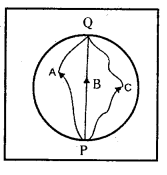
సాధన:
ప్రతి బాలిక స్థానభ్రంశము \(\overline{\mathrm{PQ}}\) కి సమానము. PQ = 2 × 200 = 400. B అను బాలికకు మాత్రమే స్థానభ్రంశము మరియు మార్గం పొడవు సమానము.
ప్రశ్న 9.
1 km, వ్యాసార్ధం ఉన్న పార్క్ కేంద్రం నుంచి సైకిల్పై బయలుదేరిన ఒక వ్యక్తి వృత్త అంచు P కి చేరుకుని, వృత్త పరిధిపై సైకిల్ తొక్కుతూ తిరిగి వృత్త కేంద్రాన్ని పటంలో చూపిన OQ రేఖ వెంబడి చేరుకొన్నాడు. పూర్తి తిరుగు ప్రయాణానికి 10 నిమిషాలు తీసుకొంటే (a) ఫలిత స్థానభ్రంశం ఎంత ?, (b) సగటు వేగం, (c) సైకిల్ తొక్కే వ్యక్తి సగటు వడి ఎంత ?
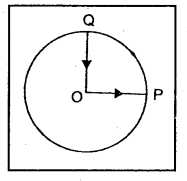
సాధన:
a) ఫలిత స్థానభ్రంశము సున్న.
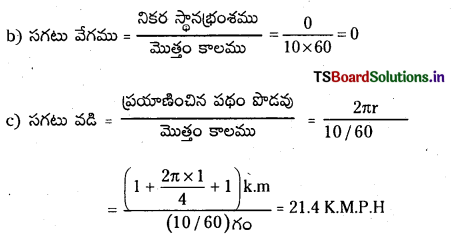
ప్రశ్న 10.
కొత్తగా పట్టణానికి వచ్చిన ప్రయాణీకుడు స్టేషన్ నుండి నేరుగా ఉన్న రోడ్డుపై 10 km దూరంలో ఉండే హోటలు చేరుకోవాలనుకున్నాడు. మోసగాడు అయిన ఒక టాక్సీ కారు డ్రైవరు అతనిని మెలికల మార్గాల గుండా తిప్పుతూ 23 km దూరాన్ని 28 నిమిషాలపాటు తిప్పి హోటల్కు తీసుకొని వచ్చాడు. అయితే (a) టాక్సీ సగటు వడి ఎంత ? (b) సగటు వేగం పరిమాణం ఎంత ? (c) ఈ రెండూ సమానమేనా ?
సాధన:
ప్రయాణ మార్గం పొడవు S = 23 k.m. స్థానభ్రంశము = 10 k.m.
కాలము = 28 ని = \(\frac{28}{60}\) గం.

ఈ సందర్భంలో సగటు వేగము మరియు సగటు వడి సమానం కాదు.
ప్రశ్న 11.
30 ms-1 వడితో వర్షం నిట్టనిలువుగా పడుతోంది. ఒక మహిళ 10 ms-1 వడితో ఉత్తరం నుంచి దక్షిణ దిశకు సైకిలు తొక్కుతోంది. ఏ దిశలో ఆమె గొడుగును పట్టుకోవాలి ?
సాధన:
పటం నుండి వర్షం 30 మీ॥ సె వడితో OA దిశలో పడుతున్నది.
మహిళ 10 మీ/సె వేగంతో OS దిశలో చలిస్తున్నది.
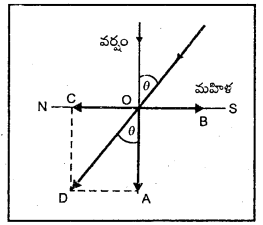
వాన నుండి రక్షించుకోవడానికి ఆమె సాపేక్ష వేగానికి వ్యతిరేక దిశలో గొడుగు పట్టుకోవాలి.
సాపేక్ష వేగం కనుక్కోవడానికి మహిళ వేగాన్ని వ్యతిరేక దిశలో తీసుకొని ఫలిత వేగం కనుక్కోవాలి.
పటంలో సమాంతర చతుర్భుజము OADC లో కర్ణము OD ఫలిత వేగము (సాపేక్ష వేగం) ను ఇస్తుంది.
దాని దిశను tan θ = \(\frac{\mathrm{AD}}{\mathrm{OA}}=\frac{\mathrm{OC}}{\mathrm{OA}}=\frac{10}{30}\) = 0.3333 = tan 18°26′
అనగా గొడుగు పట్టుకోవలసిన దిశ క్షితిజలంబం నుండి 18°26′ కోణంతో మహిళ నడిచేవైపు పట్టుకోవాలి.
ప్రశ్న 12.
నిలకడగా ఉన్న నీటిలో ఒక వ్యక్తి 4.0 km/h వడితో ఈదగలడు. 1.0km వెడల్పు ఉండి 3.0 km/h సమవడితో ప్రవహిస్తున్న నదిని ప్రవాహ దిశకు లంబంగా ఈదుతూ ఎంత కాలంలో దాటగలడు ? రెండో ఒడ్డుకు చేరేటప్పటికి అతడు నదిలో ఎంత కిందకు ప్రయాణిస్తాడు ?
సాధన:
నది వెడల్పు = 1 k.m., వ్యక్తి వేగము = 4 KMPH
నదిని దాటడానికి పట్టిన కాలము
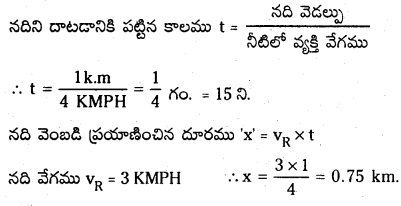

ప్రశ్న 13.
పెద్ద హాలు లోకప్పు 25 m ఎత్తు ఉంది. 40ms వడితో విసిరిన బంతి హాలు లోకప్పును తాకకుండా వెళ్ళే గరిష్ఠ క్షితిజ సమాంతర దూరం ఎంత ?
సాధన:
తొలి వేగము vo = 40 మీ/సె. కప్పు ఎత్తు H = 25 మీ.
కప్పును తాకుతూ వెళ్ళడానికి ప్రక్షేపక కోణము ‘θ’ అనుకోండి.
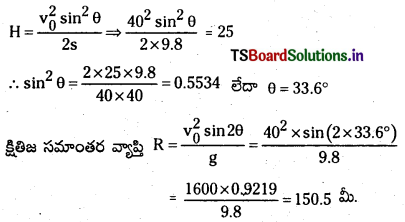
ప్రశ్న 14.
ఒక క్రికెటర్ బంతిని గరిష్ఠంగా 100 m దూరం విసరగలడు. అదే బంతిని భూమికి ఎంత ఎత్తు వరకు అతడు విసరగలడు?
సాధన:
ప్రక్షేపక వేగం v0 అనుకోండి. గరిష్ఠ వ్యాప్తి Rmax = \(\frac{v_0^2}{g}\) = 100 మీ.
∴ ప్రక్షేపక కోణము θ = 45°
అదే వేగం v0 తో నిట్టనిలువుగా పైకి విసరితే అది చేరగల ఎత్తు
y = y0 + v0t + \(\frac{1}{2}\)at2
ఇందులో y0 = 0,
కాలము t = \({\mathrm{v}_0}{\mathrm{~g}}\)
∴ y = 0 + v0 . \({\mathrm{v}_0}{\mathrm{~g}}\) – \(\frac{1}{2} \mathrm{~g}\left(\frac{v_0}{g}\right)^2\)
⇒ y = \(\frac{\mathrm{v}_0^2}{\mathrm{~g}}-\frac{1}{2} \frac{\mathrm{v}_0^2}{\mathrm{~g}}\)
= 100 – \(\frac{1}{2}\) × 100 = 50
∴ నిట్టనిలువుగా పైకి చేరగల ఎత్తు y = 50 మీ.
ప్రశ్న 15.
80 cm పొడవు ఉన్న తాడుకు ఒక కొన వద్ద రాయిని కట్టి స్థిర వడితో క్షితిజ సమాంతర వృత్తంలో తిప్పారు. రాయి 25 s లలో 14 భ్రమణాలు చేస్తే, రాయి త్వరణం పరిమాణం, దిశను కనుక్కోండి.
సాధన:
తాడు పొడవు = వ్యాసార్ధము r = 80 సెం.మీ. = 0.8 మీ; భ్రమణాల సంఖ్య = 14 ; కాలము t = 25 సె.
ω = భ్రమణ వేగము = \(\frac{14}{25}\) భ్రమణాలు/సె.
ω = \(\frac{14 \times 2 \times 22}{25 \times 7}=\frac{88}{25}\) రే/సె.
అభిలంబ త్వరణము a⊥ = ω2r = \(\frac{88}{25} \times \frac{88}{25}\) × 0.8 = 9.90 మీ/సె2
ప్రశ్న 16.
ఒక విమానం స్థిర వడి 900 km/h తో 1.00 km వ్యాసార్ధం వున్న క్షితిజ సమాంతర వలయాన్ని పూర్తిచేసింది. దాని అభికేంద్ర త్వరణాన్ని గురుత్వ త్వరణంతో పోల్చండి.
సాధన:
విమానం వడి = 900 KMPH = \(\frac{900 \times 5}{18}\) = 250 మీ/సె
వ్యాసార్ధము r = 1 k.m. = 1000 మీ.
అభిలంబ త్వరణము a = \(\frac{v^2}{r}=\frac{250 \times 250}{1000}\) = 62.5 మీ/సె2
అభిలంబత్వరణము, గురుత్వ త్వరణాల నిష్పత్తి \(\frac{62.5}{9.8}\) = 6.38

ప్రశ్న 17.
కింది ప్రచవనాలను జాగ్రత్తగా చదివి తప్పొప్పుల కారణాలను ఇవ్వండి :
a) వృత్తాకార చలనంలో ఉన్న కణం ఫలిత త్వరణం ఎప్పుడూ వ్యాసార్ధం వెంబడి వృత్తకేంద్రంవైపు ఉంటుంది.
b) ఏదైనా బిందువు వద్ద కణం వేగ సదిశ ఆ బిందువు వద్ద పథం స్పర్శరేఖ వెంబడి ఉంటుంది.
c) ఏకరీతి వృత్తాకార చలనంలో ఒక పూర్తి భ్రమణంలో కణం సగటు త్వరణం ఒక శూన్య సదిశ.
సాధన:
a) ప్రవచనం తప్పు. ఏకరీతి వృత్తాకార చలనంలో మాత్రమే ఫలిత త్వరణం వృత్త వ్యాసార్ధం వెంబడి ఉంటుంది.
b) ప్రవచనం సరి అయినది. ఎందుకనగా వస్తువు వృత్తాకార మార్గం వదిలేటపుడు ఆ బిందువు వద్ద గల స్పర్శరేఖ వెంబడి ప్రయాణిస్తుంది.
c) ప్రవచనం సరి అయినది. ఒక పూర్తి భ్రమణానికి వేగ సదిశలలో ఫలిత మార్పు సున్న కావున కణం త్వరణము సున్న.
ప్రశ్న 18.
ఒక కణం స్థానం కింది విధంగా ఉంది.
r = \(3.0 \mathrm{t} \hat{\mathrm{i}}-2.0 \mathrm{t}^2 \hat{\mathrm{j}}+4.0 \hat{\mathrm{k}}\)
ఇక్కడ t (కాలం) సెకనులో, ప్రమాణాలు మీటర్లలో ఉండే విధంగా ఇతర గుణకాల ప్రమాణాలు ఉన్నాయి. (a) కణం యొక్క v, a లను కనుక్కోండి, (b) t = 2.0 s వద్ద కణం వేగం పరిమాణం, దిశ ఏమిటి ?
సాధన:
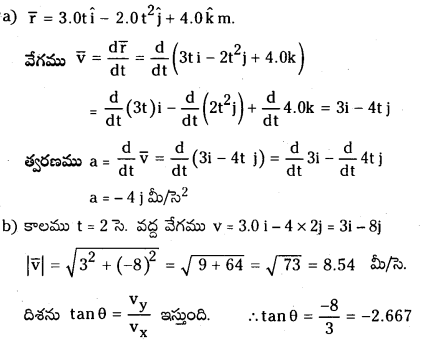
= – tan 69.5° అనగా దాని దిశ x- అక్షానికి కింది వైపు x-అక్షంతో 69.5° కోణం చేస్తుంది.
ప్రశ్న 19.
అంతరాళంలో ఏదైనా యాదృచ్ఛిక చలనానికి కింద ఇచ్చిన ఏ సంబంధాలు ఒప్పు :
(a) vaverage = (1/2) (v(t1) + v(t2))
(b) vaverage = [r(t2) – r(t1)] / (t2 – t1)
(c) v (t) = v (0) + at
(d) r(t) = r(0) + v(0) t + (1/2) a t2
(e) aaverage = [v (t2) – vt1)] / t2 – t1)
(ఇక్కడ ‘average’ పదం t1 నుంచి t2 మధ్య ఉన్న కాలవ్యవధిలో ఆయా రాశుల సగటు విలువను తెలియచేస్తుంది.)
సాధన:
పైన ఇచ్చిన వాటిలో b, e సంబంధాలు సరి అయినవి. ఎందుకనగా అవి సగటు వేగము, సగటు త్వరణముల గణిత శాస్త్రరూపాలు. మిగిలిన a, c, d అను నియమాలు సమత్వరణంతో చలించే వస్తువులకు వర్తిస్థాయి. యాదృచ్ఛిక చలనం సమత్వరణం కలిగి ఉండాలి అన్న కచ్చితమైన నిబంధన లేనందువల్ల a, c, d లు సరి అయినవి కావు.

ప్రశ్న 20.
కింది ప్రవచనాలను జాగ్రత్తగా చదివి కారణాలు, ఉదాహరణలలో తప్పొప్పులను వివరించండి :
అదిశ రాశి అనేది
(a) ఇచ్చిన ప్రక్రియలో నిత్యత్వమయ్యేది.
(b) ఎప్పుడూ రుణ విలువలను తీసుకోదు.
(c) మితులు ఉండవు.
(d) అంతరాళంలో ఒక బిందువు నుంచి మరొక బిందువుకు దాని విలువ మారదు.
(e) పరిశీలకులు వివిధ దిగ్విన్యాసాలతో కూడిన అక్షాలలో ఉన్నా దాని విలువ ఒకే విధంగా ఉంటుంది.
సాధన:
a) అబద్ధము. ఎందుకనగా అస్థితి స్థాపక అభిఘాతాలలో శక్తి నిత్యత్వము కాదు (శక్తి అదిశరాశి).
b) అబద్ధము. ఎందుకనగా ఉష్ణోగ్రత ఋణాత్మకంగా కూడా ఉండవచ్చు (ఉష్ణోగ్రత అదిశరాశి).
c) అబద్ధము. ఎందుకనగా సాంద్రతకు మితులు కలవు. సాంద్రత అదిశరాశి.
d) అబద్ధము. ఎందుకనగా అంతరాళంలో ఒకచోట నుండి మరొకచోటుకు గురుత్వ పొటెన్షియల్ (ఇది అదిశరాశి) మారుతుంది కావున.
e) నిజమైనది. ఎందుకనగా అదిశ పరిమాణము పరిశీలకుల దృగ్విన్యాసంతో మారదు కావున.
ప్రశ్న 21.
భూమికి 3400 m ఎత్తున ఒక విమానం ఎగురుతోంది. భూమిపై ఉన్న పరిశీలన బిందువు వద్ద ఆ విమానం 10.0 s కాలవ్యవధిలో 30° కోణం చేస్తే వడి ఎంత ?
సాధన:
పటంలో ‘O’ అనేది భూమిపై పరిశీలన బిందువు. A, B అను బిందువులు ‘O’ వద్ద చేసే కోణము ∠AOB = 30°. A, B లకు గీసిన మధ్య లంబరేఖ OC = 3400. ∠AOC = ∠COB = 15°.
A నుండి Bకి విమానం ప్రయాణించిన కాలము t = 10 సె.
పటంలో AC = OC tan 15° = 3400 × 0.2679 = 910.86 మీ.
AB = AC + BC – 910.86 + 910.86 = 1821.7 మీ.
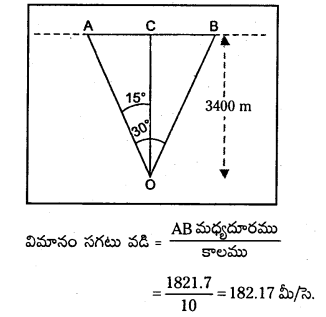
ప్రశ్న 22.
ఒక సదిశకు పరిమాణం, దిశ ఉన్నాయి. దానికి అంతరాళంలో స్థానం ఉంటుందా ? అది కాలంతో మారుతుందా ? అంతరాళంలో వివిధ స్థానాల దగ్గర ఉన్న రెండు సమాన సదిశలు a, bలు సర్వసమాన భౌతిక ప్రభావాలను చూపించవలసిన ఆవశ్యకత ఉందా ? మీ సమాధానానికి మద్దతుగా ఉదాహరణలివ్వండి.
సాధన:
- ఒక సదిశ యొక్క దిశ, పరిమాణం మారకుండా దానిని ఎక్కడికైనా జరపవచ్చు. కావున సదిశకు అంతరాళంలో నియమతస్థానం ఉండదు.
- సదిశ పరిమాణం కాలంతో పాటు మారవచ్చు. ఉదా : త్వరణం కలిగిన వస్తువు వేగం నిరంతరం మారుతుంది.
- అంతరాళంలో రెండు వేరు వేరు ప్రదేశాలలో ఉన్న సమాన సదిశలు ఒకే ప్రభావం చూపవలసిన అవసరం లేదు.
ఉదా : ఒక వస్తువు మీద వ్యతిరేక దిశలో వేరు వేరు బిందువుల వద్ద పనిచేసే బలాలు ఒకే రకమైన టార్క్ను ఉత్పత్తి చేయవు.

ప్రశ్న 23.
ఒక సదిశకు పరిమాణం, దిశ ఉన్నాయి. అంటే దిశ, పరిమాణం ఉన్న ప్రతీది సదిశ కావలసిన ఆవశ్యకత ఉందా? వస్తువు భ్రమణాన్ని దాని భ్రమణాక్షం దిశ, భ్రమణ కోణంతో వ్యక్తపరచవచ్చు. అంటే ప్రతి భ్రమణం సదిశ అవుతుందా?
సాధన:
దిశ, పరిమాణం ఉన్న ప్రతీది సదిశ కానవసరం లేదు. సదిశలు తప్పనిసరిగా సంకలన నియమాలు పాటించాలి.
ఉదా : కాంతి వేగము. ఇది సదిశ కాదు.
వస్తువును భ్రమణ అక్షపరంగా భ్రమణం చెందించితే అది సదిశ కానవసరం లేదు. ఎందుకనగా అది సదిశల సంకలన నియమాల వంటి నియమాలను పాటించదు. కాని భ్రమణ కోణము 9 చిన్నదైతే అది సదిశల సంకలన నియమాలను పాటిస్తుంది కాబట్టి అటువంటి సందర్భంలో భ్రమణాన్ని సదిశగా భావిస్తారు.
ప్రశ్న 24.
కింది వాటితో సదిశలను జతచేయవచ్చా ? వివరించండి. (a) ఉచ్చు (loop) ఆకారంలో వంచిన తీగ పొడవు (b) ఒక తల వైశాల్యం, (c) గోళం.
సాధన:
a) ఉచ్చు ఆకారంలో వంచిన తీగతో సదిశను జతచేయలేదు.
b) సమతలంతో ఒక సదిశను జత చేయవచ్చు. ఇటువంటి దానిని విస్తీర్ణ సదిశ అంటారు. తలానికి గీసిన లంబదిశలో దీన్ని సూచిస్తారు.
c) గోళ ఘనపరిమాణంతో సదిశను జత చేయలేము కాని గోళ ఉపరితల వైశాల్యంతో సదిశను జతచేయవచ్చు.
ప్రశ్న 25.
క్షితిజ సమాంతరానికి 30° కోణంతో పేల్చిన బుల్లెట్ 3.0 km దూరంలో భూమిని తాకింది. దాని ప్రక్షేపక కోణాన్ని సరిచేసి 5.0 km దూరంలో ఉన్న లక్ష్యాన్ని గురికొట్టవచ్చని ఎవరైనా ఆశించవచ్చా ? వడి స్థిరం అని, గాలి నిరోధాన్ని ఉపేక్షించడమైంది అని అనుకోండి.
సాధన:
కోణము θ = 30° ప్రయాణించిన దూరము = వ్యాప్తి = 3కి.మీ. 3000 మీ.
g = 10 మీ/సె2
వ్యాప్తి R = \(\frac{\mathrm{u}^2 \sin 2 \theta}{\mathrm{g}}\) ⇒ 3 = \(\frac{\mathrm{u}^2}{\mathrm{~g}}\) sin60° ⇒ 3 = \(\frac{u^2}{g} \frac{\sqrt{3}}{2} \Rightarrow \frac{u^2}{g}=\frac{3}{\sqrt{3 / 2}}=2 \sqrt{3}\) k.m. = 3.464 km.
కాని గరిష్ఠ వ్యాప్తి \(\frac{\mathrm{u}^2}{\mathrm{~g}}\) = 3.464 k.m కావున ఆ బులెట్లో 5k.m. లక్ష్యాన్ని తాకలేము.
![]()
![]()
![]()
![]()































